Sonova USA CPAIR2 Streamer & remote control device User Manual 029 0307 02 User Guide ComPilot Air II
Phonak Inc Streamer & remote control device 029 0307 02 User Guide ComPilot Air II
User Guide_English
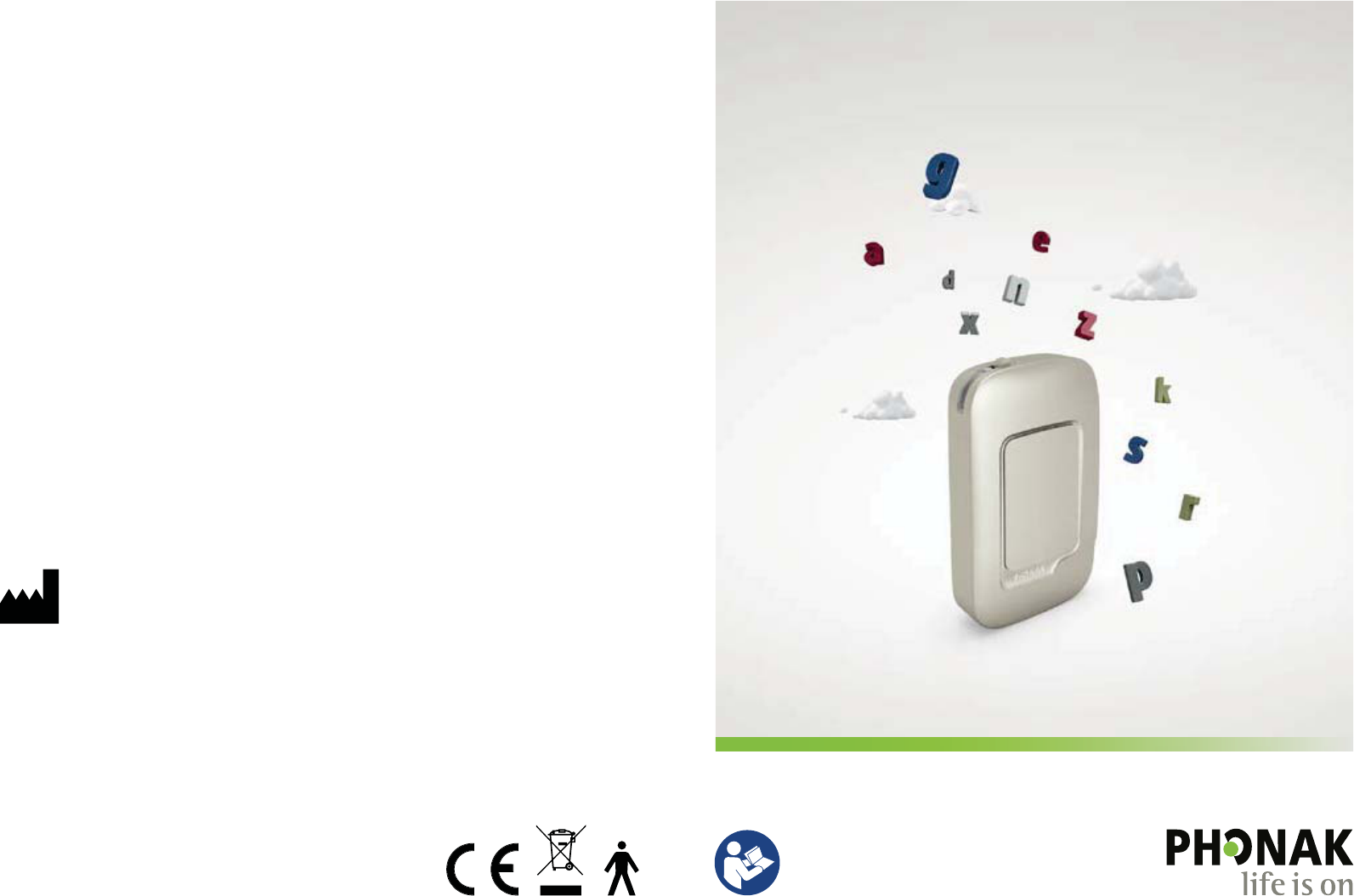
www.phonak.com
Phonak AG
Laubisrütistrasse 28
CH-8712 Stäfa
Switzerland
029-0307-02/2014-07/A+W © Phonak AG All rights reserved
User Guide
Phonak ComPilot Air II

32
1. Welcome 5
2. Getting to know your ComPilot Air II 6
2.1 Legend 7
3. Getting started 8
3.1 Setting up the power supply 8
3.2 Charging the battery 9
3.3 Switching On or O 10
3.4 How to wear 10
3.5 Sound demonstration 12
4. Phone calls using ComPilot Air II 14
4.1 How it works 14
4.2 Initial pairing to a phone 15
4.3 Connecting to the phone 17
4.4 Making a call 18
4.5 Accepting a call 19
4.6 Ending a call 20
4.7 Advanced phone options 20
4.8 Additional features 23
Contents
5. Streaming audio 25
5.1 Streaming audio via Bluetooth 25
5.2 Streaming audio from TV or hi- 28
6. Using ComPilot Air II as a remote control 29
6.1 Changing the volume 29
6.2 Changing the program 30
7. More detailed information 32
7.1 Main button functionality 32
7.2 Locking the buttons 33
7.3 Switching o the indicator light 34
7.4 Managing multiple inputs 34
7.5 Understanding the indicator lights 36
7.6 Deleting paired Bluetooth devices 38
7.7 Caller identication 39
7.8 VoiceAlerts (spoken messages) 40
7.9 Phonak RemoteControl App 41
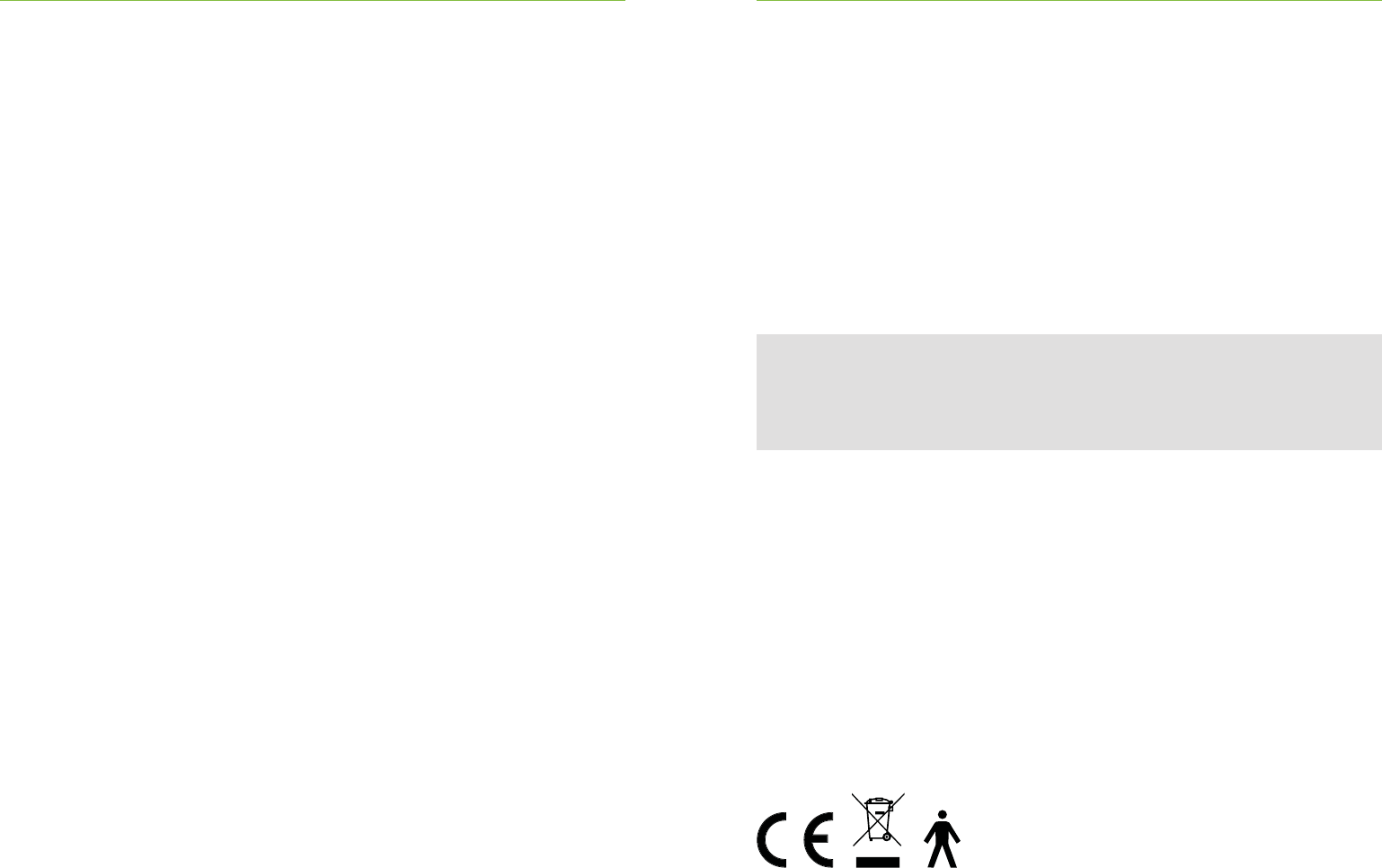
4 5
8. Troubleshooting 42
9. Service and warranty 50
9.1 Local warranty 50
9.2 International warranty 50
9.3 Warranty limitation 51
10. Compliance information 52
11. Information and explanation of symbols 55
12. Important safety information 59
Contents
Your ComPilot Air II is a premium-quality product
developed by Phonak, one of the worlds leading
companies in hearing technology.
Please read the user instructions thoroughly in order
to benet from all the possibilities your hearing system
oers.
! Compatibility information:
Check your hearing aid compatibility with your
hearing care professional.
Phonak – life is on www.phonak.com
1. Welcome
CE mark applied: 2014
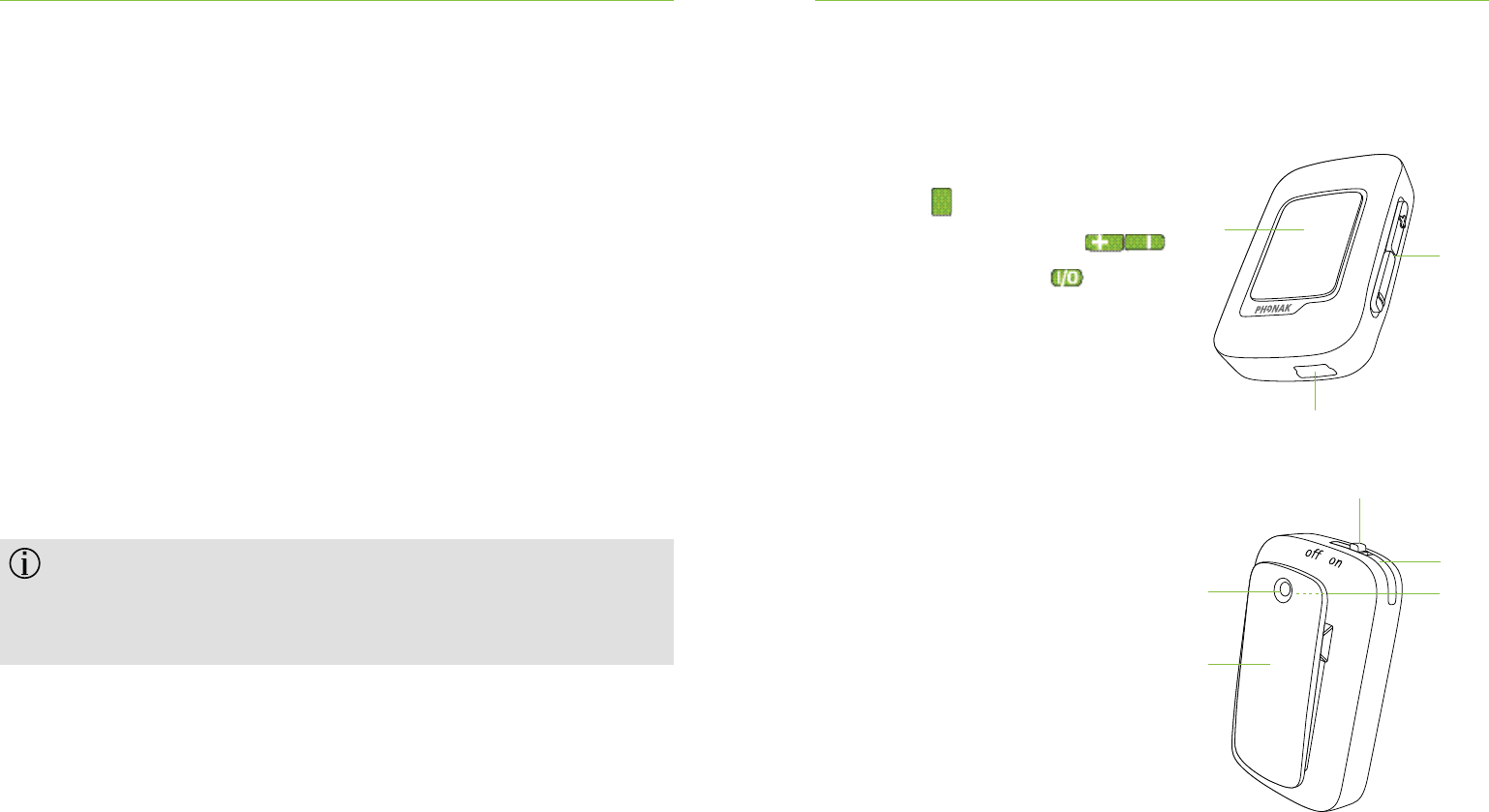
6 7
The intended use of ComPilot Air II is to receive audio
inputs from dierent Bluetooth® devices and to transmit
them wirelessly to your hearing aids.
Virtually any Bluetooth-enabled audio device such as cell
phones or MP3 players are supported. Enjoy speech and
music from other multimedia devices, such as computers,
TVs or music players.
ComPilot Air II can also be used as a remote control to
adapt your hearing aids to dierent listening situations.
Please note that your hearing care professional
must congure your ComPilot Air II before it can
be used as a remote control.
Bluetooth® is a registered trademark owned by the
Bluetooth SIG, Inc.
2. Getting to know your
ComPilot Air II 2.1 Legend
Buttons
Main
Volume up / down
On / Off switch
Inputs
Microphone opening
Charging input (mini-USB)
Others
Indicator light
Securing cord eyelet
Retaining clip
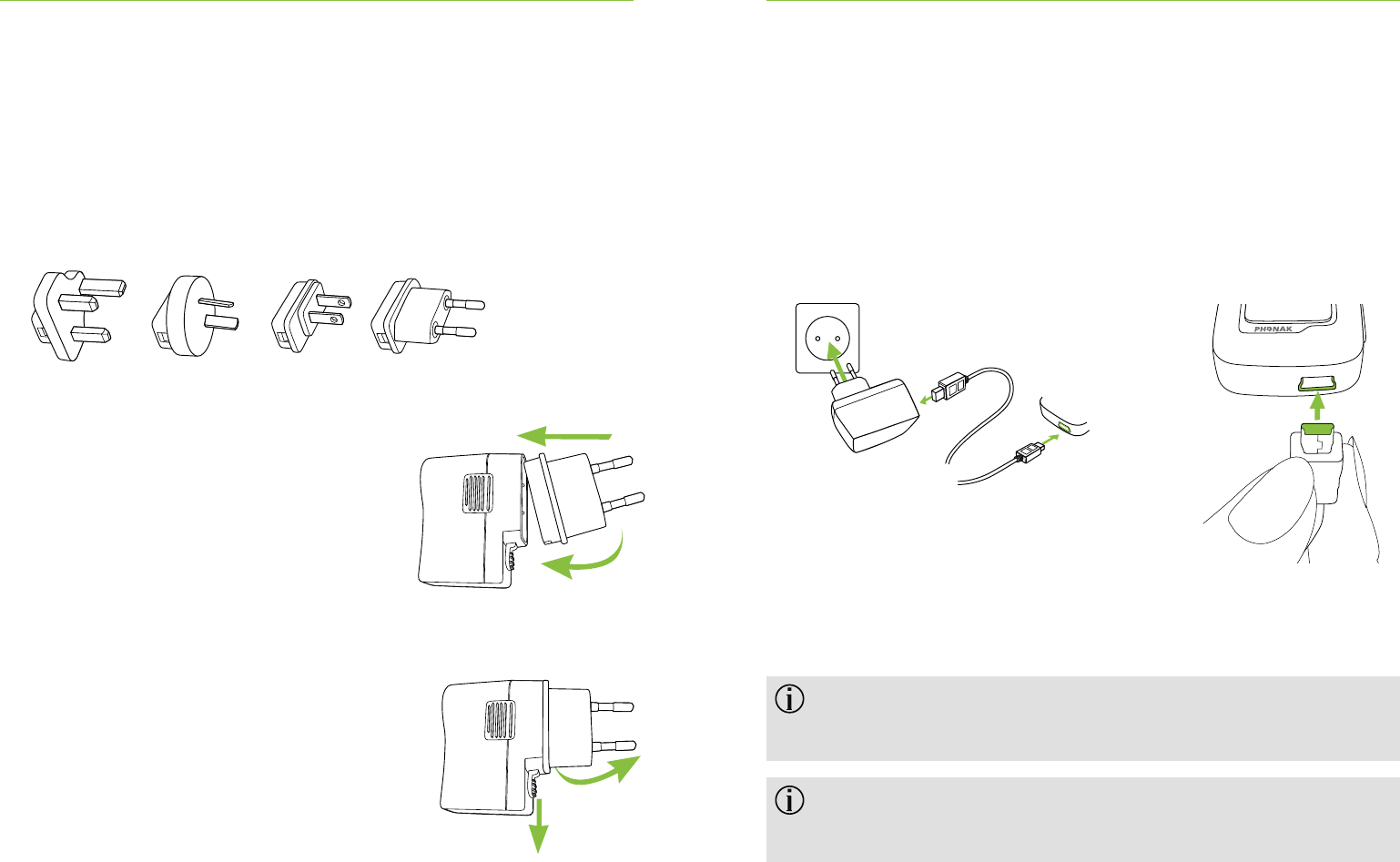
1.
1. 2.
2.
8 9
3. Getting started
ComPilot Air II must be set up and charged before use.
3.1 Setting up the power supply
Select the adapter that corresponds to your country.
UK AUS US EU
Firstly, insert the top round
end of the adapter into
the round corner of the power
supply.
Click the bottom end of the
adapter in to lock it into place.
To remove, rst pull back the tab
on the power supply.
Pull the adapter upwards to
remove it.
3.2 Charging the battery
Plug the larger end of the charging cable into the
universal power supply. Plug the smaller end into the
mini-USB port on ComPilot Air II.
Plug the power supply into a power outlet.
The indicator light is red during charging and will
turn green when charging is complete.
ComPilot Air II has a non-removable rechargeable
battery.
Before using ComPilot Air II for the rst time,
charge it for at least 3 hours.
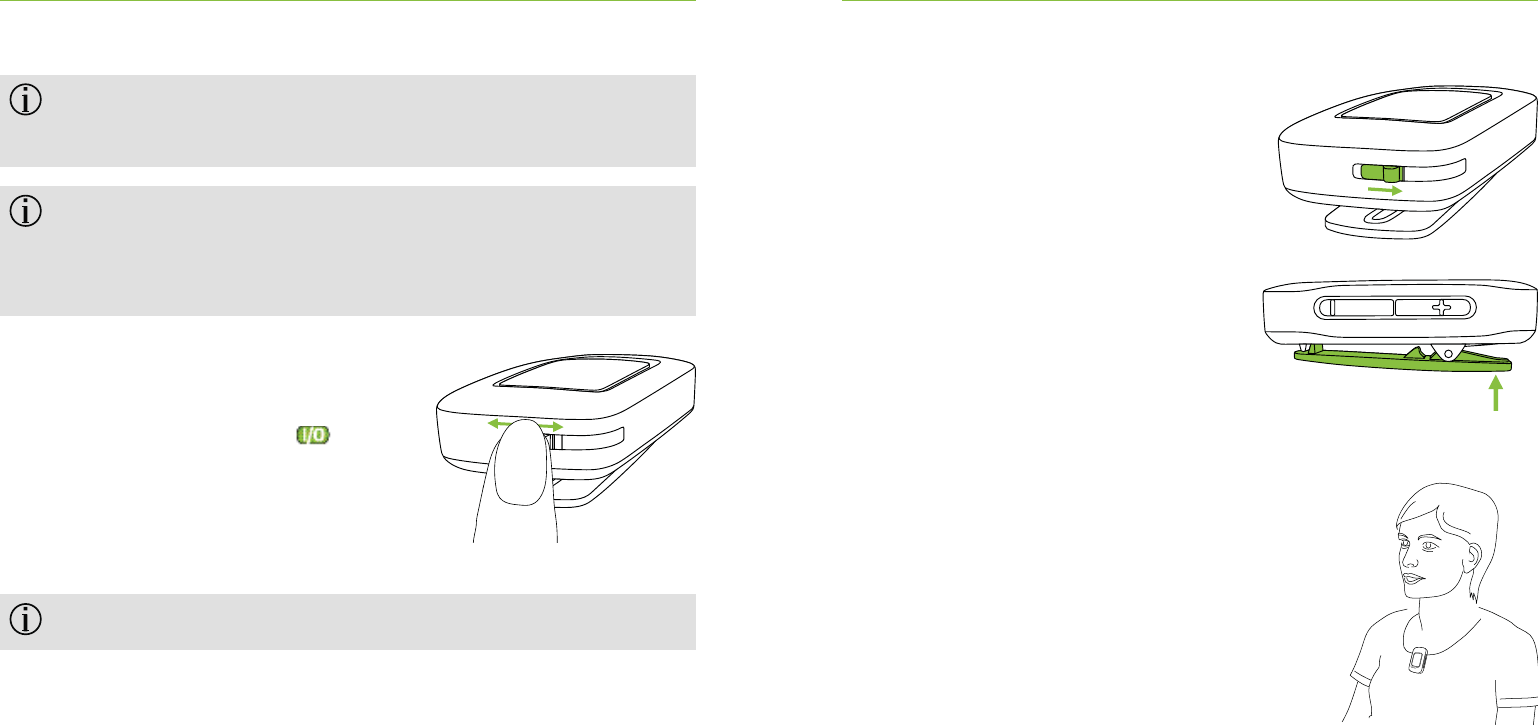
O On
10 11
3. Getting started
It is safe to leave ComPilot Air II connected
to the charger overnight.
The full performance of a new battery is achieved
only after three complete charge and discharge
cycles.
3.3 Switching On and O
Slide the power switch
as shown to turn ComPilot Air II
on or o.
Switch ComPilot Air II o when not in use.
3.4 How to wear
Before any phone call, music or TV streaming:
Insert the hearing aids into your ears correctly
and switch them on.
Switch ComPilot Air II on.
Clip it securely on to
your clothing.
Distance to the mouth:
The best results are achieved at
20 cm (8").
A distance of 40 cm (16") to
the hearing aids should not be
exceeded.
To prevent scratching sounds, do not
cover ComPilot Air II with clothing
during phone calls.
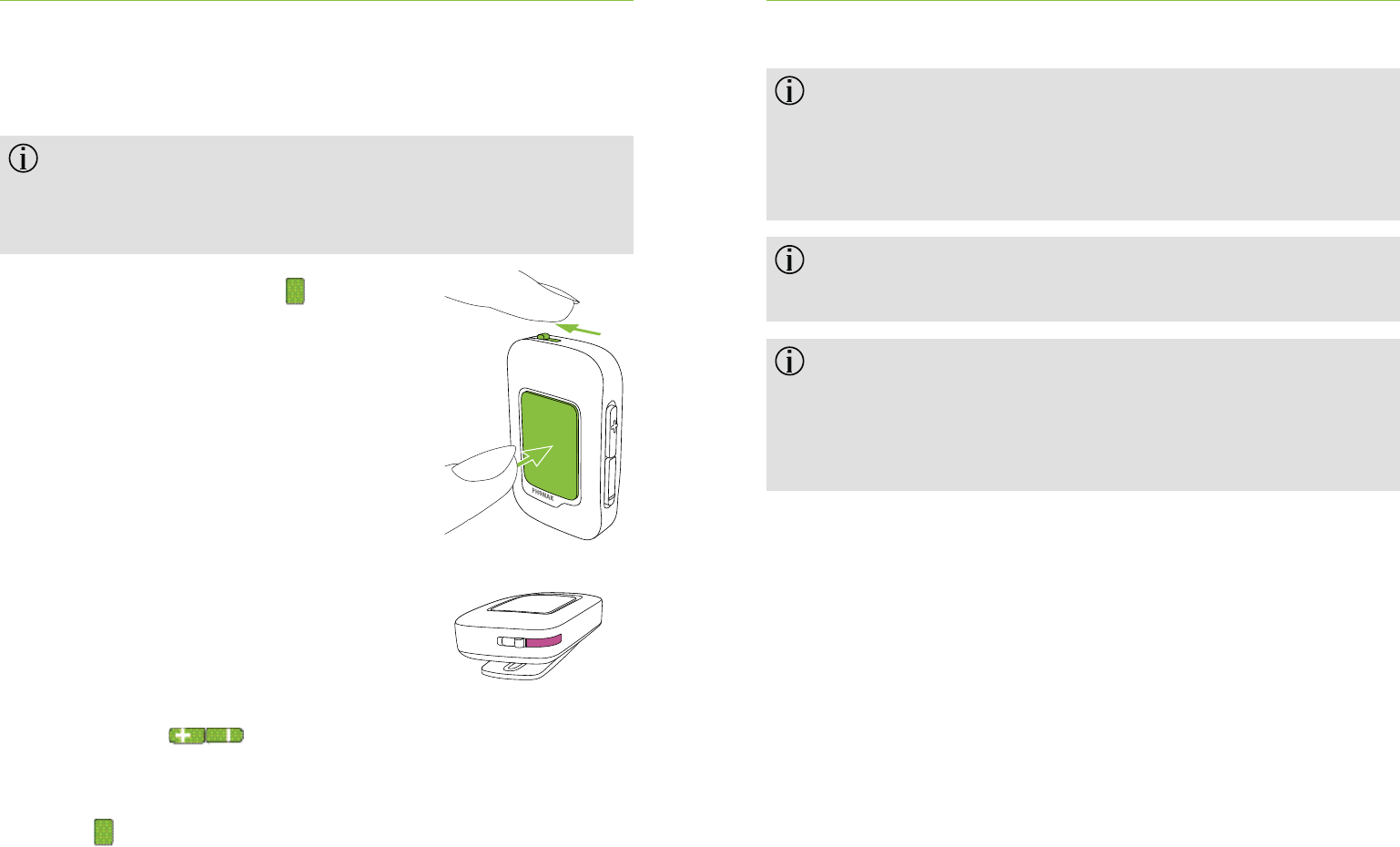
12 13
3.5 Sound demonstration
Wear your hearing aids and clip ComPilot Air II
securely to your cloth within 40 cm (16") of your
hearing aids (see chapter 3.4).
Press and hold the main button
while switching on the device.
The indicator light will turn pink.
The hearing aids will switch to
streaming mode and you will hear
the sound demonstration.
Use volume buttons to adjust the volume.
The demo will stop after 3 minutes or when the
main button is pressed.
3. Getting started
Adjusting the volume during the sound
demonstration will also set the volume level
of the spoken ComPilot Air II messages
(see chapter 7.8).
If you cannot hear the sound demonstration, please
consult the troubleshooting section.
The default language setting of a new
ComPilot Air II is English and can be congured
by your hearing care professional or the Phonak
RemoteControl App (see chapter 7.9).
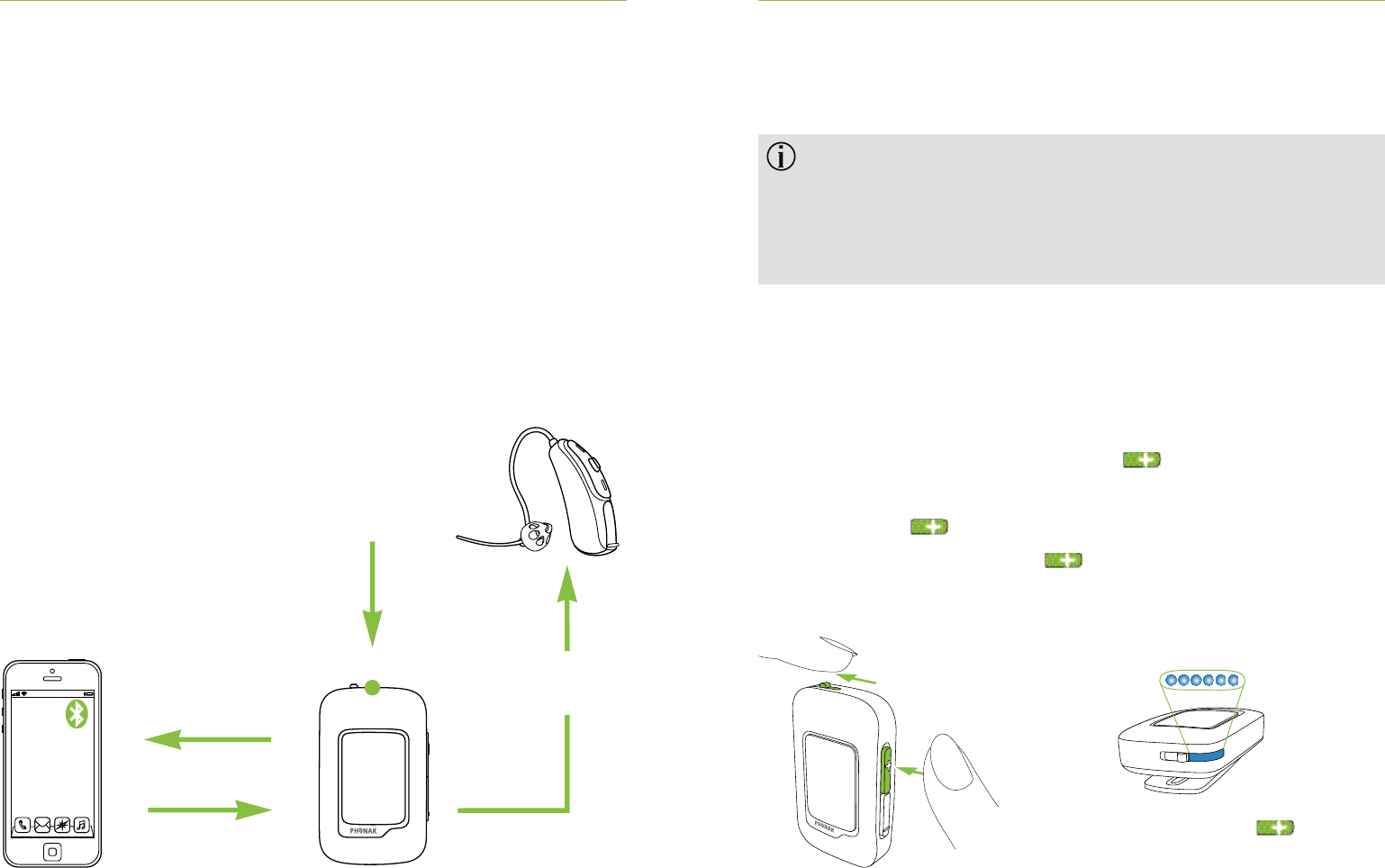
2.
1.
14 15
4.1 How it works
ComPilot Air II acts as an interface between the phone
and your hearing aids. During a call you will hear the
callers voice directly in your hearing aids.
ComPilot Air II picks up your voice through its own
microphone. Speak into ComPilot Air II – not into the
phone – when a call is in progress.
4. Phone calls using ComPilot Air II
Own voice
Caller’s voice
Max. 40 cm
(16")
Communication
4.2 Initial pairing to a phone
It is only necessary to perform the pairing procedure
once with each Bluetooth device. ComPilot Air II
will connect automatically to the phone after the
initial pairing.
On your phone, ensure that Bluetooth is enabled
and search for Bluetooth devices in the connectivity
setting menu.
Switch ComPilot Air II o.
Press and hold the volume up button.
Turn ComPilot Air II on whilst still pressing the
volume up button.
Release the volume up button when the indicator
light starts rapidly blinking blue.
Bluetooth pairing: + on.

16 17
A quick pairing instruction is also shown on the back
of ComPilot Air II.
Start the pairing process on the phone within
1 minute according to the phone user guide.
Your phone shows a list of found Bluetooth devices.
Select “Phonak ComPilot Air II” from this list and
enter code “0000” if prompted.
ComPilot Air II requires access to your phone book.
When prompted accept the request.
After successful pairing, the indicator light will stop
rapidly blinking blue.
For more information about Bluetooth pairing
instructions specic to some of the most popular
phone manufacturers, go to:
http://www.phonak.com/compilotair
4.3 Connecting to the phone
Wear your hearing aids and clip ComPilot Air II securely
to your cloth within 40 cm (16") distance to your
hearing aids and switch them on (see chapter 3.4).
After your phone has been paired to ComPilot Air II,
they will automatically connect to each other.
If they do not connect automatically, go to your
phone’s Bluetooth menu and select ComPilot Air II
from the list.
Please consult your phone’s user guide in the case
where a manual connection is necessary.
Conrmation of successful connection is indicated on
ComPilot Air II by the indicator light blinking blue.
4. Phone calls using ComPilot Air II
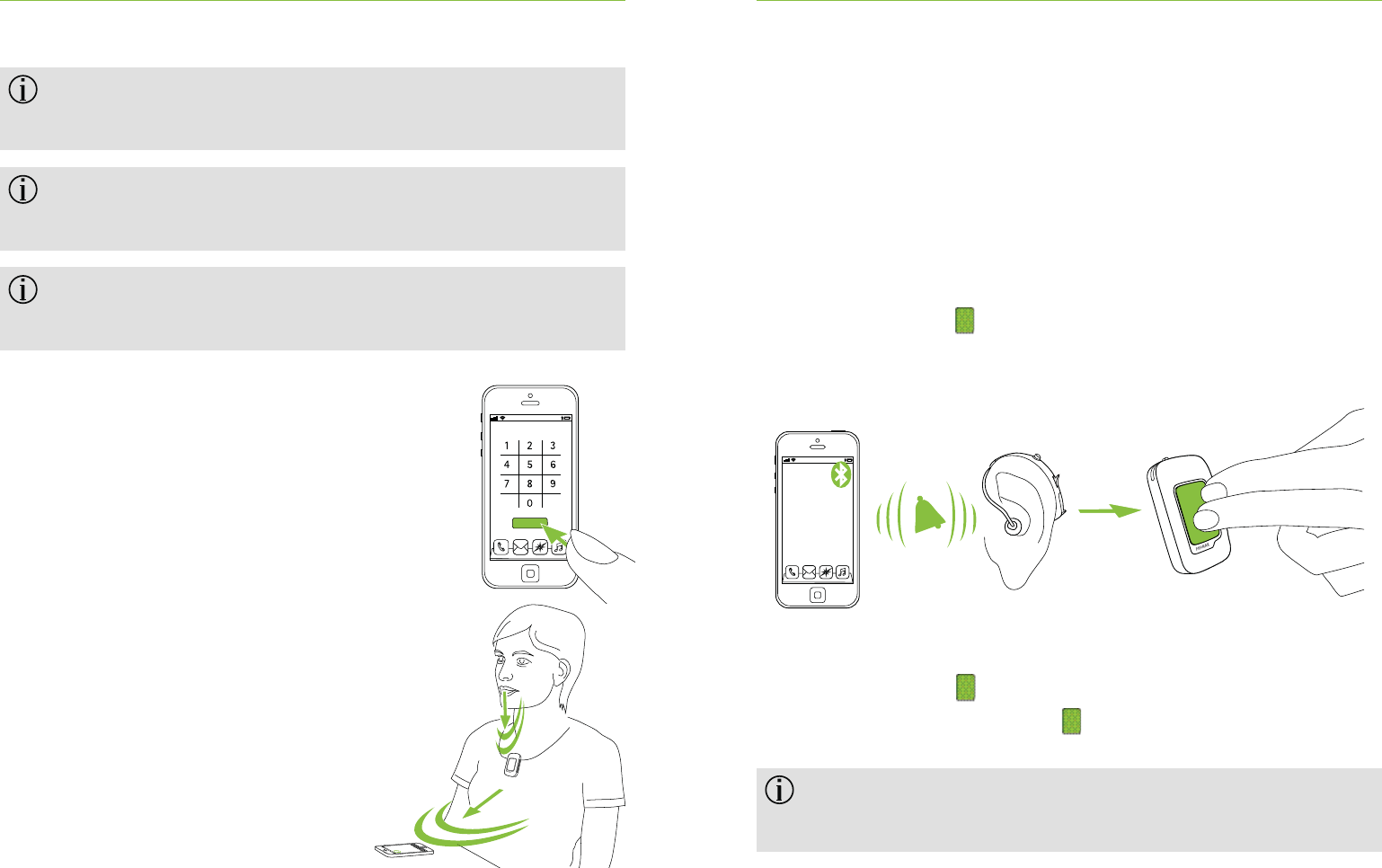
Call
18 19
The connection will be maintained as long as the
devices remain on and within range.
ComPilot Air II can connect to two phones at the
same time but only one call at a time is possible.
When pairing to a phone we recommend to disable
the phone key tones and SMS alerts.
4.4 Making a call
Enter the phone number using the phone
keypad and press the dialing button.
You will hear the dialing tone through
your hearing aid.
Speak into ComPilot Air II – not
into the phone – when the
call is in progress.
4.5 Accepting a call
When a call is received on your cell phone:
ComPilot Air II indicator light will show a solid
blue light.
It will take about 2 seconds before you hear the
ringtone through your hearing aids.
Press the main button on your ComPilot
Air II once you hear the ringtone through your
hearing aids.
If a second call comes in on the same phone:
Press the main button to accept.
Press and hold the main button (2 sec) to reject.
An incoming call from a second paired phone will
be ignored during an active call.
4. Phone calls using ComPilot Air II
“click”
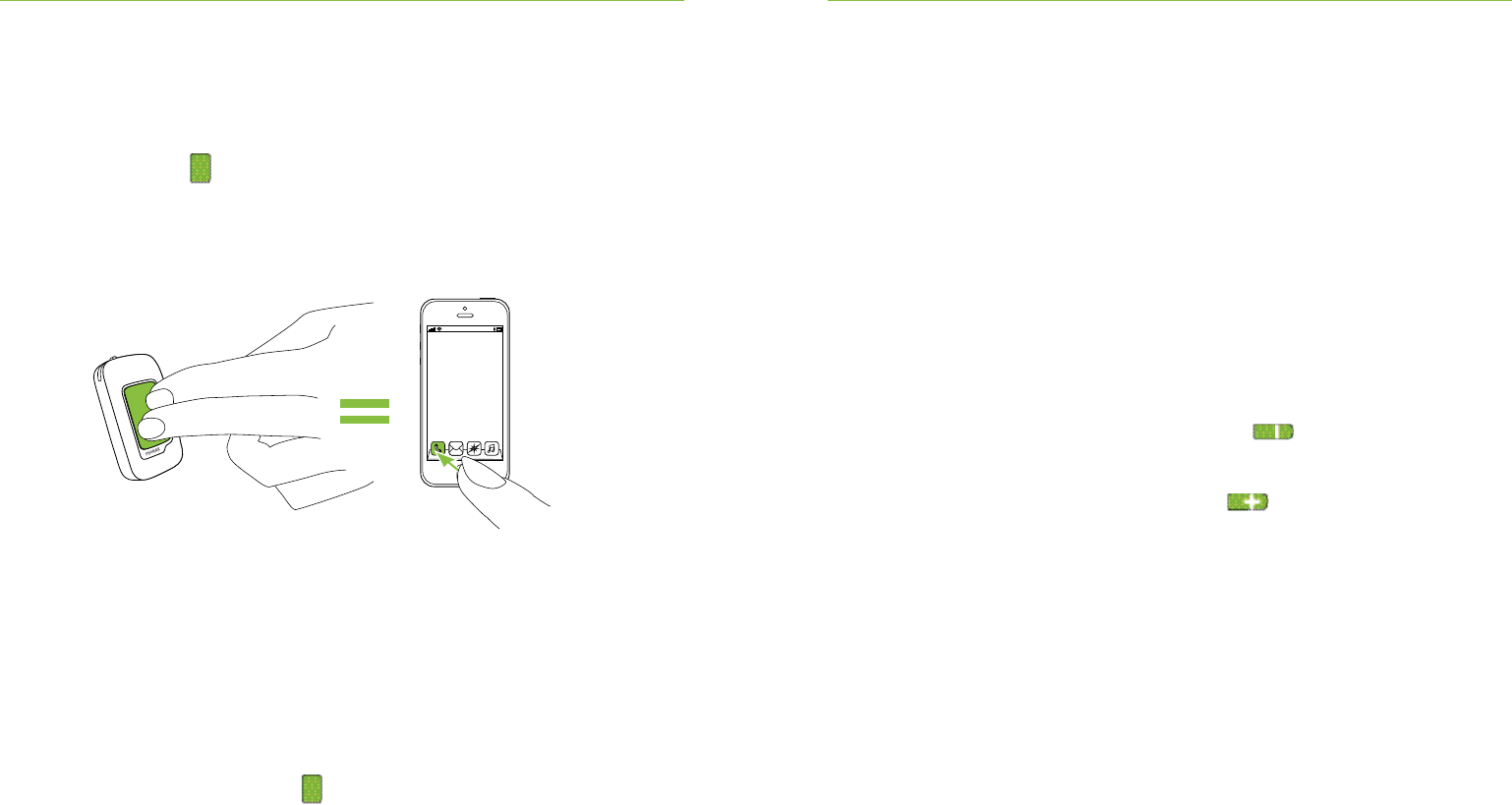
20 21
4.6 Ending a call
Press the main button to end the call.
You can also end a call on your phone instead of your
ComPilot Air II.
You will hear the previously active program or audio
source.
4.7 Advanced phone options
Rejecting a call
Press and hold the main button (2 sec) until the
ringtone stops. Using your phone to reject the call will
have the same eect.
Setting the phone volume
Use the phone’s volume buttons to adjust the phone
volume to a comfortable level.
For better understanding of a call, surrounding sounds
picked up by the hearing aids are attenuated according
to the settings made by the hearing care professional.
For additional attenuation of surrounding sounds:
Press and hold the volume down button 2 sec for
more reduction.
Press and hold the volume up button 2 sec to
return to the default attenuation.
Disabling unwanted alerts
Some cell phones are congured to play key-press
tones, SMS announcements and conrmation beeps.
You are able to hear these alerts in your hearing aids.
If this is disturbing, refer to your phone user guide for
information about disabling these alerts.
4. Phone calls using ComPilot Air II
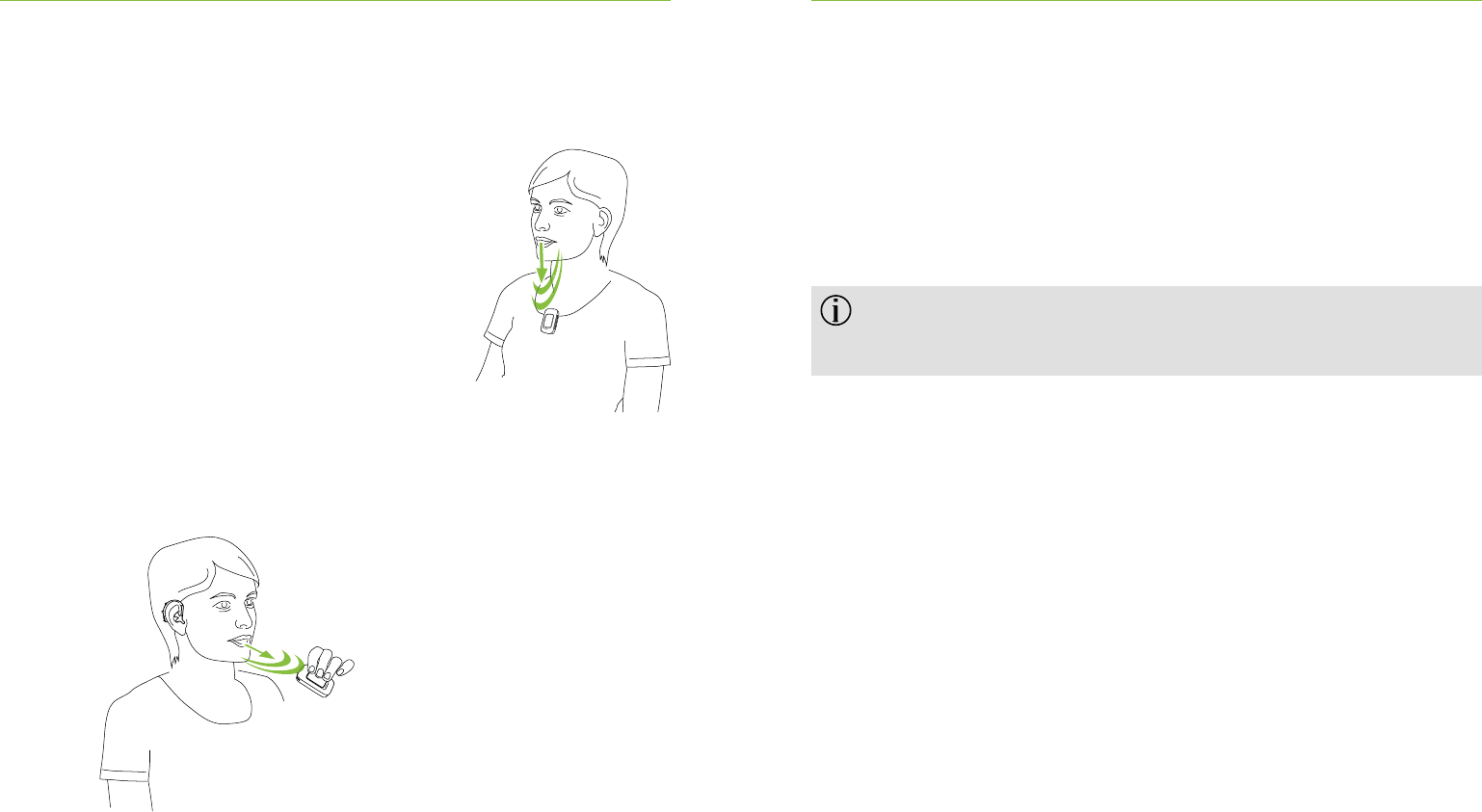
22 23
How to wear ComPilot Air II during phone calls
During phone calls, wear
ComPilot Air II clipped securely
to clothing as shown.
Note: Maximum distance
between ComPilot Air II and the
phone is 5–10 m (15–30 ft).
In very noisy environments, you can move ComPilot
Air II closer to your mouth.
4.8 Additional features
The following features can be set either using the
Phonak RemoteControl App (see chapter 7.9) or by
your hearing care professional.
Your phone must support these features. Please
consult the phone user manual for details.
Caller’s name announcement
By default, ComPilot Air II will announce the
caller's name as shown on the phone display (caller
identication).
The following features can be enabled separately.
Press and hold the Main button (2 sec.) to use them:
1. Last number redial: To redial the last dialed number.
2. Voice dial: Allows you to say the person’s name instead
of typing the number.
3. Dial preferred number: Directly dials a predened
number.
4. Phone calls using ComPilot Air II
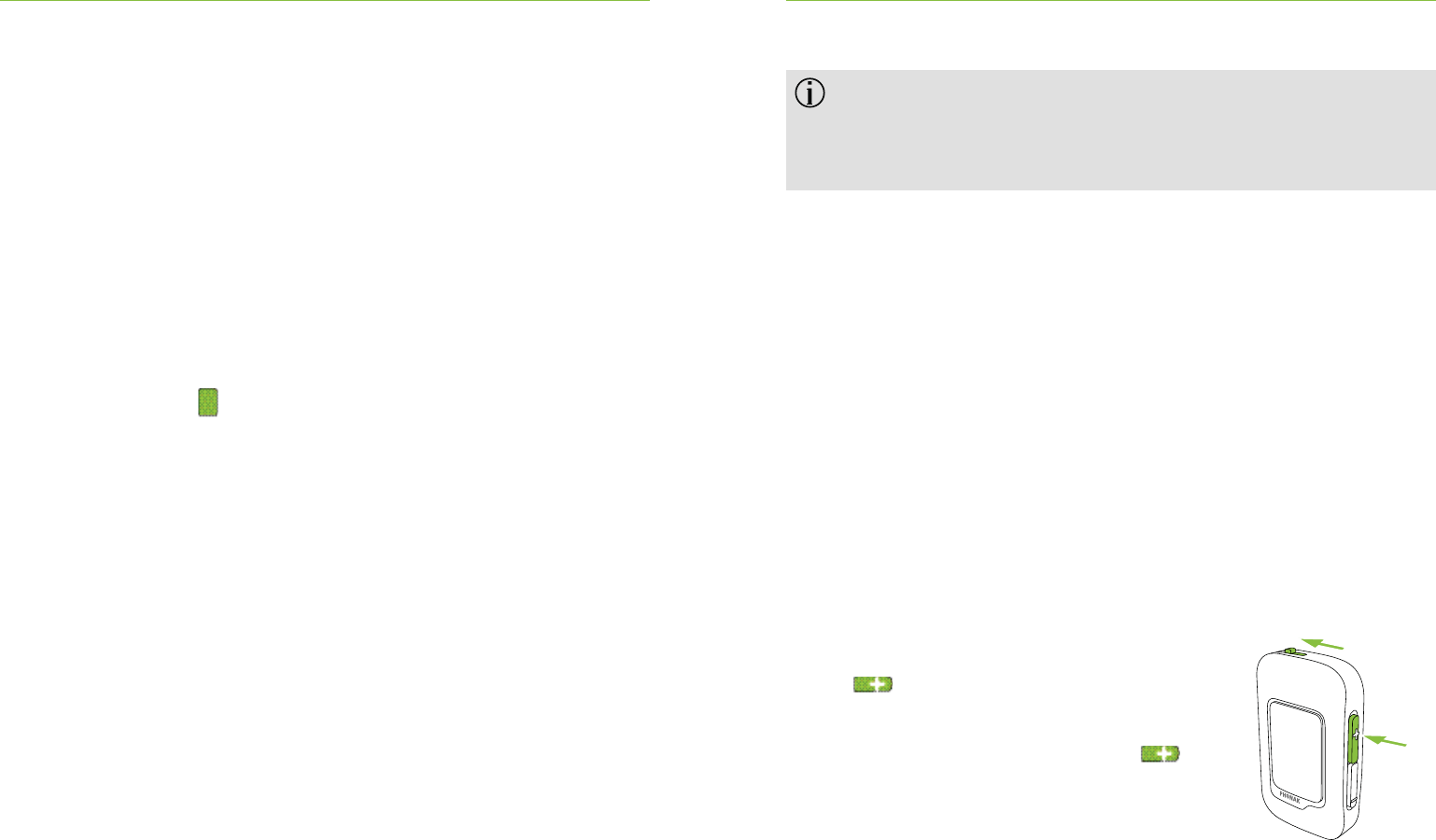
2.
1.
24 25
4. Hold call: While in a phone conversation, this will put
the call on hold. The caller stays on the line but there
is no audio transfer and the hearing aids switch to
the previously active hearing program.
5. Transfer call: This allows you to hand your phone to
another person. Your hearing aids will switch back to
the previously active hearing program.
To transfer the call back to ComPilot Air II, press and
hold the main button. The call will now resume
through your hearing aids.
5. Streaming audio
Before streaming, wear your hearing aids and
ComPilot Air II correctly and switch them on
(see 3.4).
5.1 Streaming audio via Bluetooth
Streaming audio via cell phone
You can stream music wirelessly from your cell phone:
Make sure ComPilot Air II is connected to your phone
as described in chapter 4.3.
Use your phone music player to play music.
Streaming audio via other devices
To use ComPilot Air II with a Bluetooth enabled audio
device (e.g. MP3 player), you must rst pair the devices:
Switch the ComPilot Air II o.
Press and hold the volume
up button.
Switch ComPilot Air II on whilst
still pressing the volume up
button.
4. Phone calls using ComPilot Air II
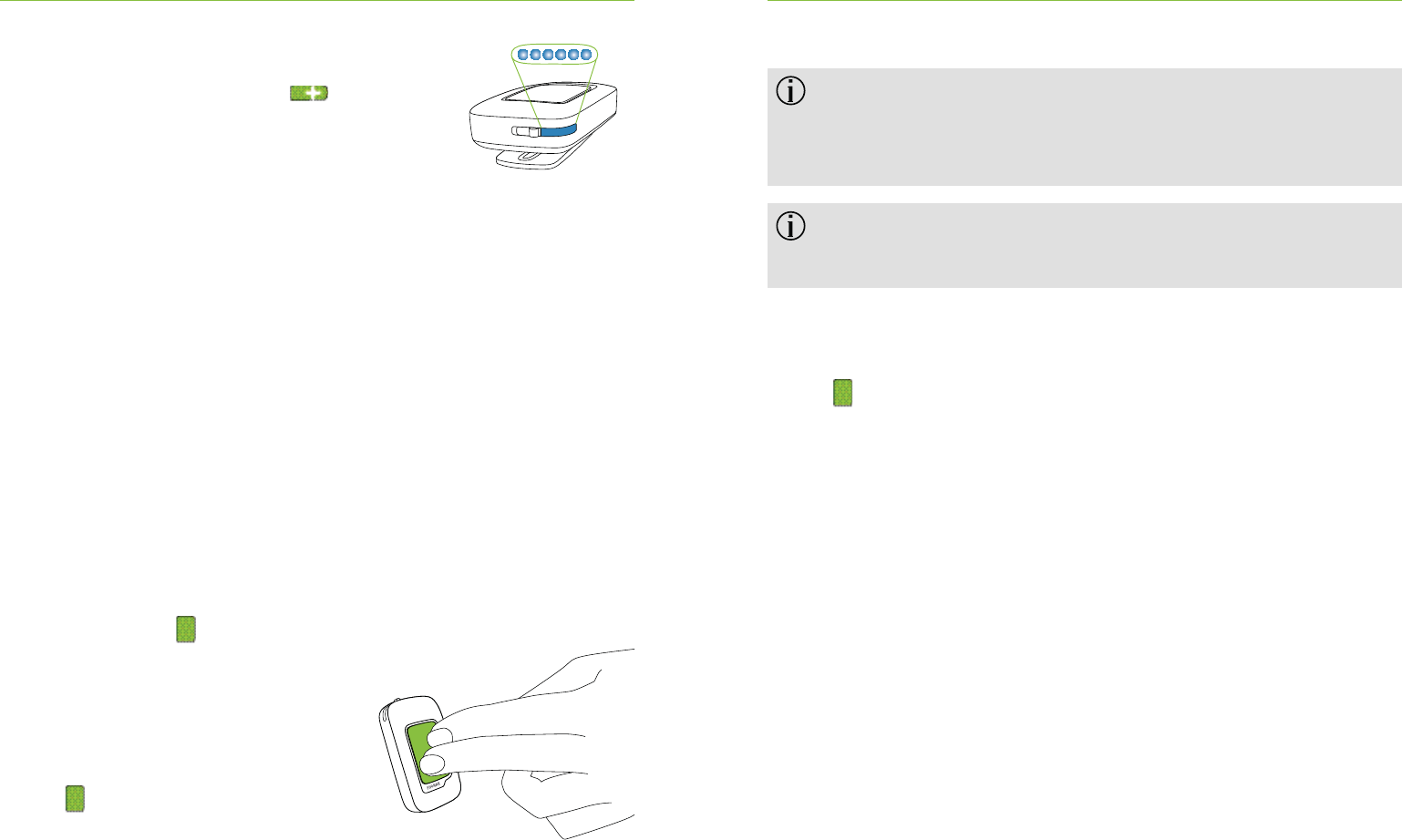
26 27
Release the volume up button
when the indicator light starts
rapidly blinking blue.
Start the pairing process on the Bluetooth device
within 1 minute according to the device’s user guide
and use code “0000” if prompted.
After successful pairing, the indicator light will stop
rapidly blinking.
Press play on the Bluetooth device if needed.
Streaming will start automatically and the indicator
light will turn solid blue indicating the active
streaming.
To adjust the volume of the audio signal use the volume
controls on the audio device.
Press the main button to
pause and restart streaming.
To stop Bluetooth streaming
completely, press and hold the
main button (2 sec), switch
the other Bluetooth device o or
disable its Bluetooth feature.
Please refer to the device’s user guide or
dealer support if you cannot complete the pairing
procedure with the generic steps described.
Maximum ComPilot Air II streaming time is 6 hours
with a fully charged battery.
Note: During streaming, ComPilot Air II cannot be
used as hearing aid remote control. Press and hold the
main button (2 sec) to stop the Bluetooth stream
completely.
5. Streaming audio
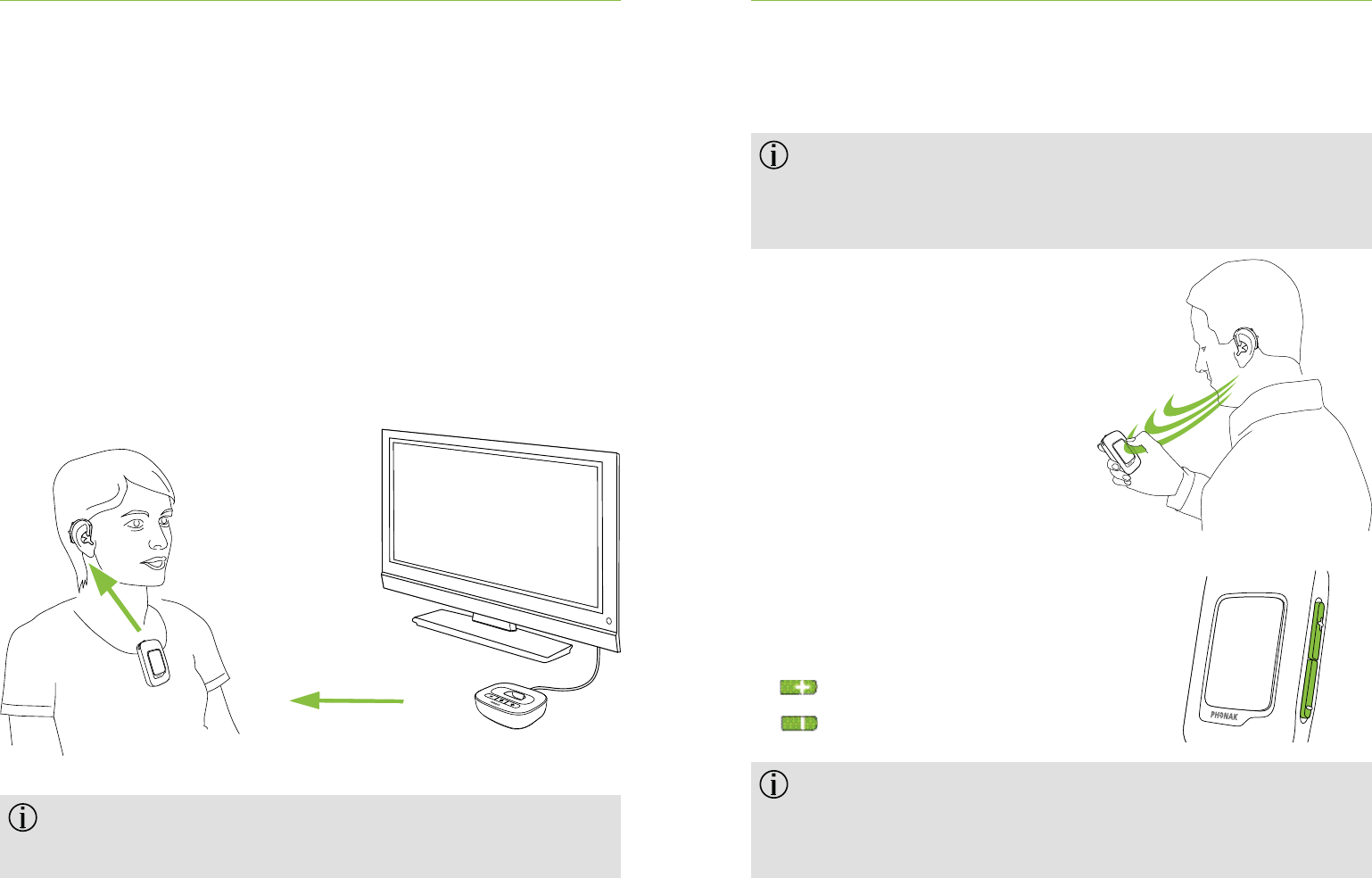
28 29
5.2 Streaming audio from TV or hi-
It is recommended to use the dedicated and optimized
Phonak TVLink II basestation for watching TV or
listening to music through it.
It oers the following benets:
Wireless transmission up to 30 meters (90 ft).
Analog and digital inputs (optical, coaxial).
Charging cradle for ComPilot Air II.
Refer to the TVLink II user guide for pairing
instructions.
6. Using ComPilot Air II as a
remote control
Before this functionality can be used, your hearing
care professional must enable the remote control
in ComPilot Air II.
If ComPilot Air II is used as a
handheld remote control:
Max. distance to the
hearing aids is
55 cm / 22".
Hold ComPilot Air II as
shown.
6.1 Changing the volume
Press buttons:
to increase the volume
to decrease the volume
Adjusting the volume with ComPilot Air II will
have the same eect as adjusting the volume
directly on your hearing aids.
5. Streaming audio
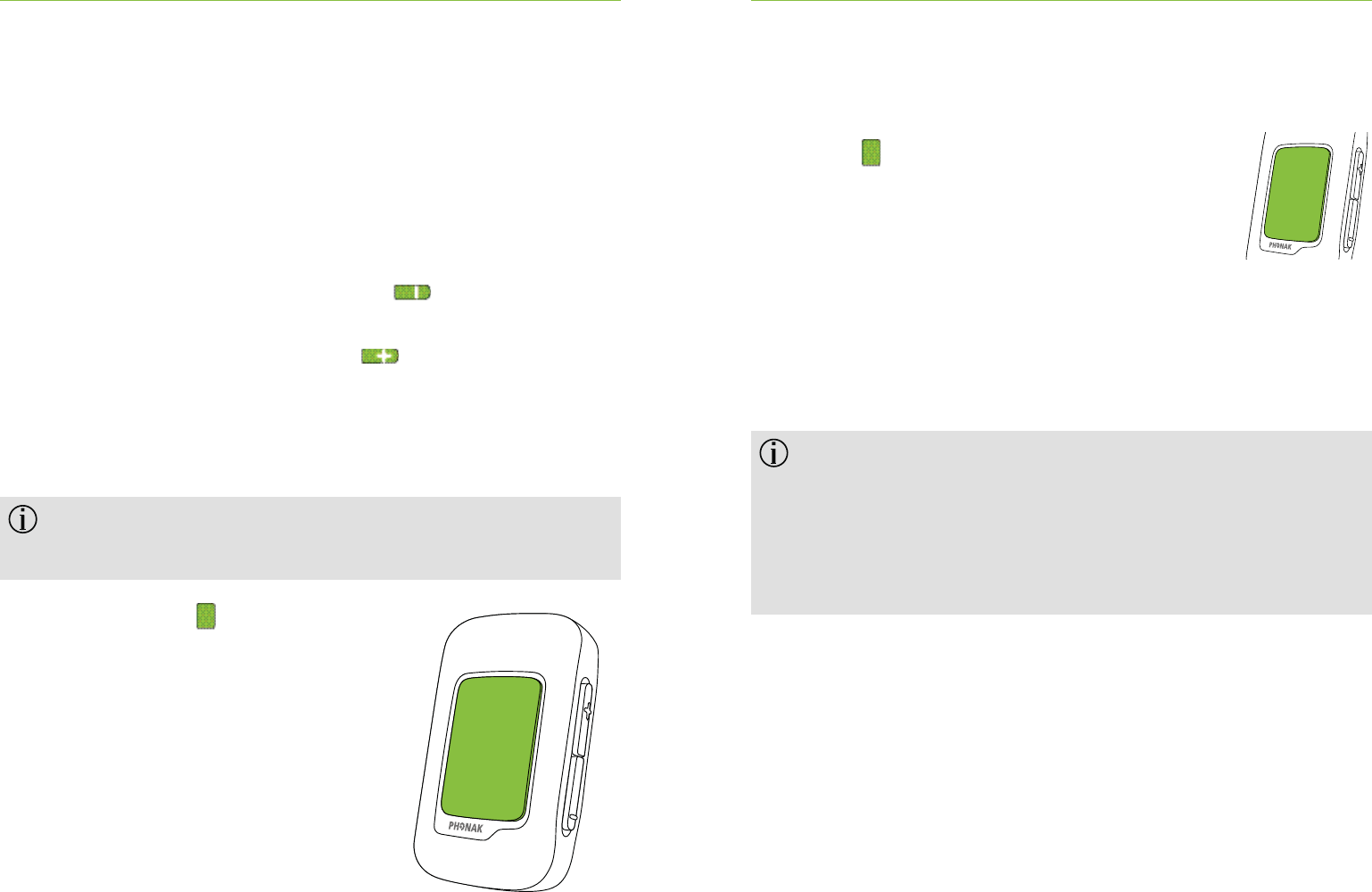
30 31
Reducing surrounding sounds
You can reduce the surrounding sounds with a single
button press. This may be helpful during music or phone
streaming. The level of reduction is set by your hearing
care professional.
Press and hold the volume down button (>2 sec)
for more reduction.
Press and hold the volume up button (>2 sec) to
return to the original hearing aid volume.
6.2 Changing the program
Changing hearing programs is only possible if no
streaming is in progress.
Press the main button to
proceed to the next available
program.
6. Using ComPilot Air II as a remote control
7.1 Main button functionality
The Main button has multiple
functionalities:
1. Phone: It accepts and ends a phone call.
2. Stream: It pauses and resumes
the streaming from an audio device. A long press
(2 sec) will disconnect the streaming and programs
can be changed again.
3. Remote control: Used to change the hearing programs.
The hearing programs cannot be changed when:
a phone call is in progress
a Bluetooth device is streaming or paused
the remote control feature was not enabled by
the hearing care professional
7. More detailed information
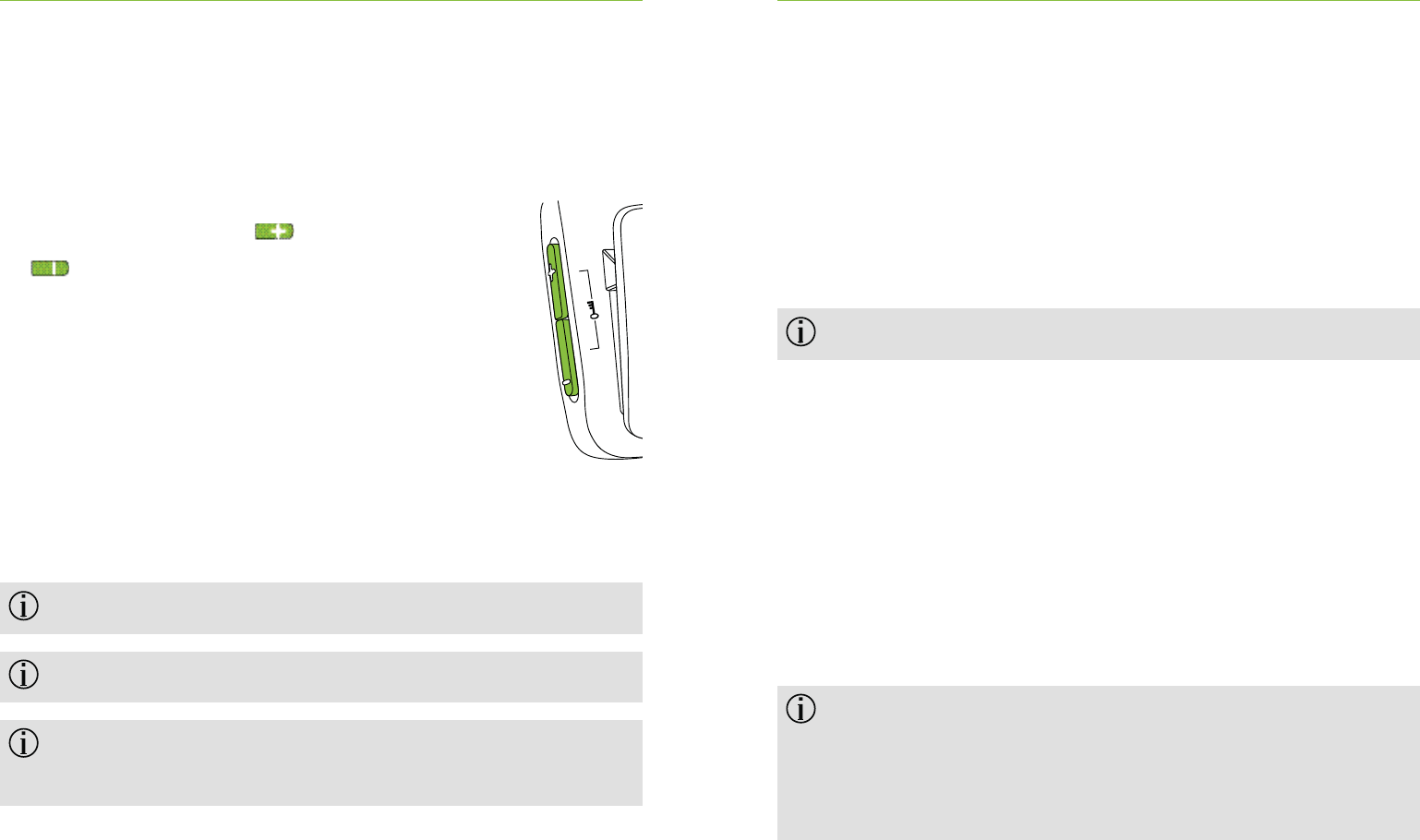
32 33
7.2 Locking the buttons
To prevent the buttons being accidentally
pressed:
Press the volume up and down
buttons simultaneously to lock
or unlock the buttons.
The indicator light will triple blink
red indicating that the buttons are
locked.
When locked, the indicator light will
triple blink and you may hear a triple
beep through the hearing aids each
time a button is pressed.
Accepting an incoming call is still possible.
In locked state, the indicator light will stop blinking.
The key symbol on the back reminds you of the
lock function.
7.3 Switching o the indicator light
If the indicator light is disturbing:
Lock the ComPilot Air II as described in chapter 7.2.
During locked state the indicator light remains
switched o.
A low battery state will be shown.
7.4 Managing multiple inputs
When an audio source is connected via ComPilot Air II,
your hearing aids will automatically switch to the special
streaming programs.
It is possible to have two Bluetooth audio sources
connected.
A phone call always has priority.
You will hear the ringtone even when listening to
other audio sources. If you reject or terminate the
call, audio streaming will resume.
7. More detailed information
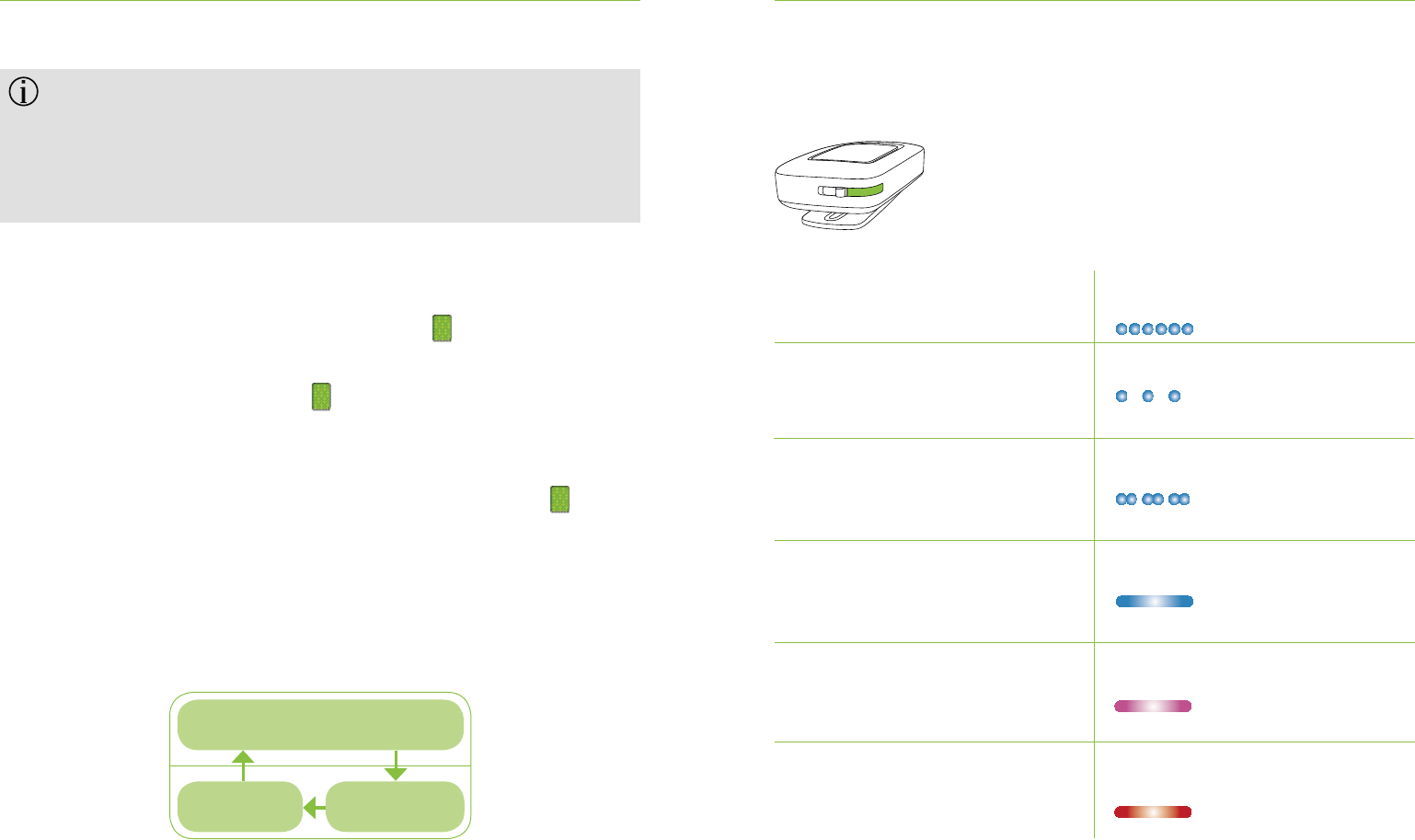
Previously-active
hearing program
Bluetooth 1Bluetooth 2
34 35
If you want to listen to music from your connected
mobile phone, you must start the music via
your phone initially; it cannot be started from
ComPilot Air II.
Selecting audio sources
One source: Each press of the main button will
pause or resume the source.
Press and hold the main button (2 sec) to
completely stop the music streaming. It must be
re-started via the phone menu.
Multiple sources: After each press of the main
button, ComPilot Air II selects the next connected
source in a xed sequence.
Every connected audio source has a xed place in
the sequence, as shown in the picture.
7. More detailed information
7.5 Understanding the indicator light
Bluetooth pairing Rapid blink blue
1 Bluetooth device Short blink blue
connected
2 Bluetooth Double-blink blue
devices connected
Phone or music Solid blue
via Bluetooth
Demo sound playing Solid pink
Charging Solid Red
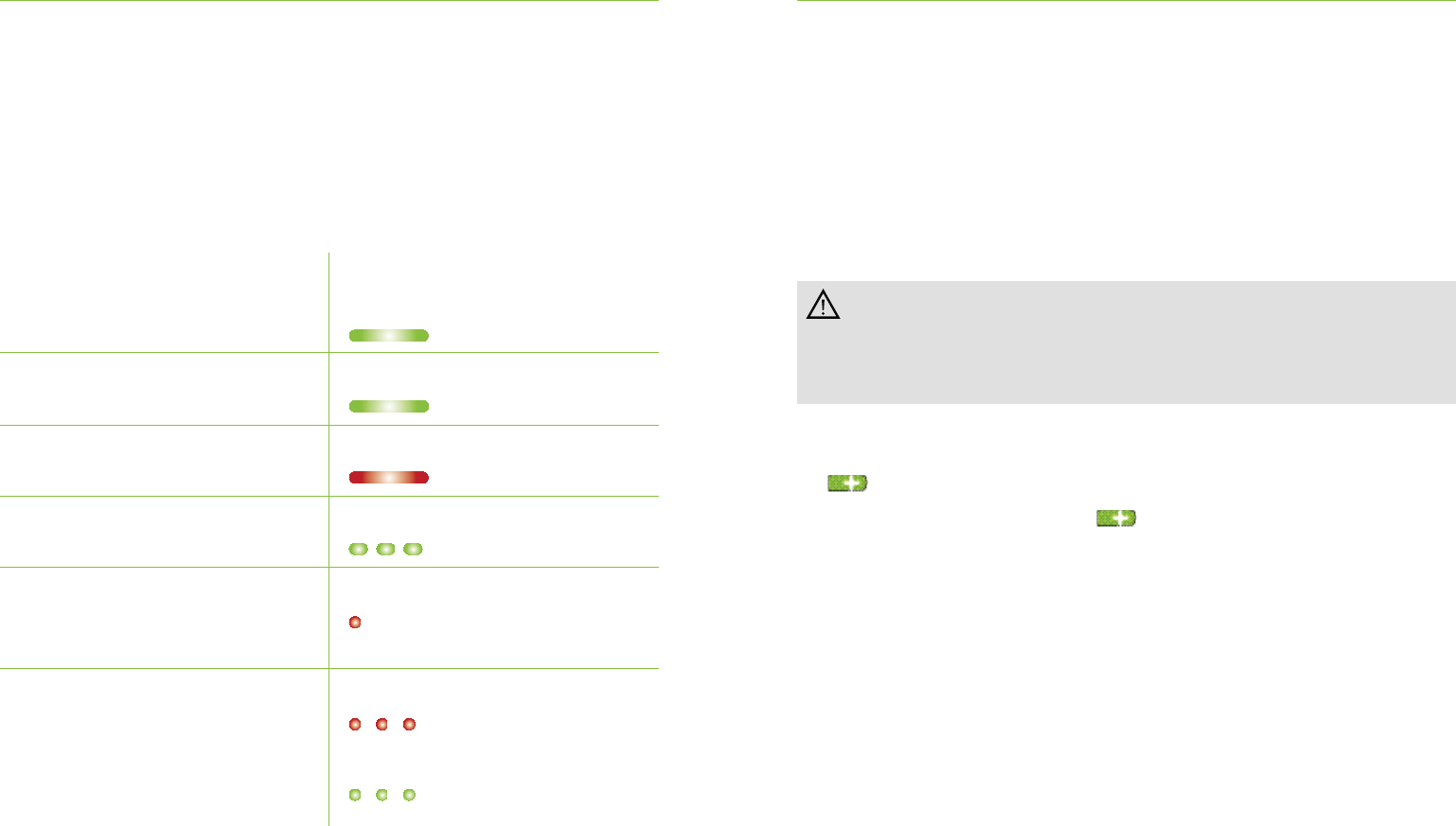
36 37
Charged and full battery Solid green
Switching On Green 2 seconds
Switching O Solid red for 2 seconds
Battery above 10% Slow blink green
<10% battery left. Short ash red
Please charge
Enable / Triple ash red (locked)
disable lock state
Triple ash green (unlocked)
7.6 Deleting paired Bluetooth devices
If you encounter issues with one of the paired
devices, you may consider deleting the pairings from
ComPilot Air II.
Deleting the pairing of Bluetooth devices removes
the ability to connect to any previously paired
Bluetooth device.
1. Turn ComPilot Air II on while pressing the volume up
button.
2. Release the volume up button only after
10 seconds when the rapidly blue blinking indicator
light turns green.
3. Delete the ComPilot Air II pairing entries on your
mobile phone before any re-pairing.
4. Repeat the pairing procedure as described in
chapter 4.2.
7. More detailed information

38 39
7.7 Caller identication
ComPilot Air II is able to tell you the name of the
caller.
ComPilot Air II will try to access information about the
caller from your phone book. It will be spoken through
your hearing aids as follows:
The stored name in your phone’s phonebook.
The number if the name is not known.
Your hearing care professional can configure the
language setting of your ComPilot Air II.
Alternatively you can also use the Phonak RemoteControl
App to congure the language setting (see chapter 7.9).
7.8 VoiceAlerts (spoken messages)
Informs you about the dierent operation modes and
status of ComPilot Air II using spoken messages.
Your hearing care professional can congure the
language setting as well as the speech levels:
Warnings only: Spoken information about a low
ComPilot Air II battery and during the Bluetooth
pairing process.
Standard: Additional information about switching
ComPilot Air II on or o, start or end charging during
streaming, input source selection announcements.
Detailed: Additional information about start or end
of charging even if no streaming source is active,
Bluetooth device connect or disconnect and transfer
or hold a call.
7. More detailed information
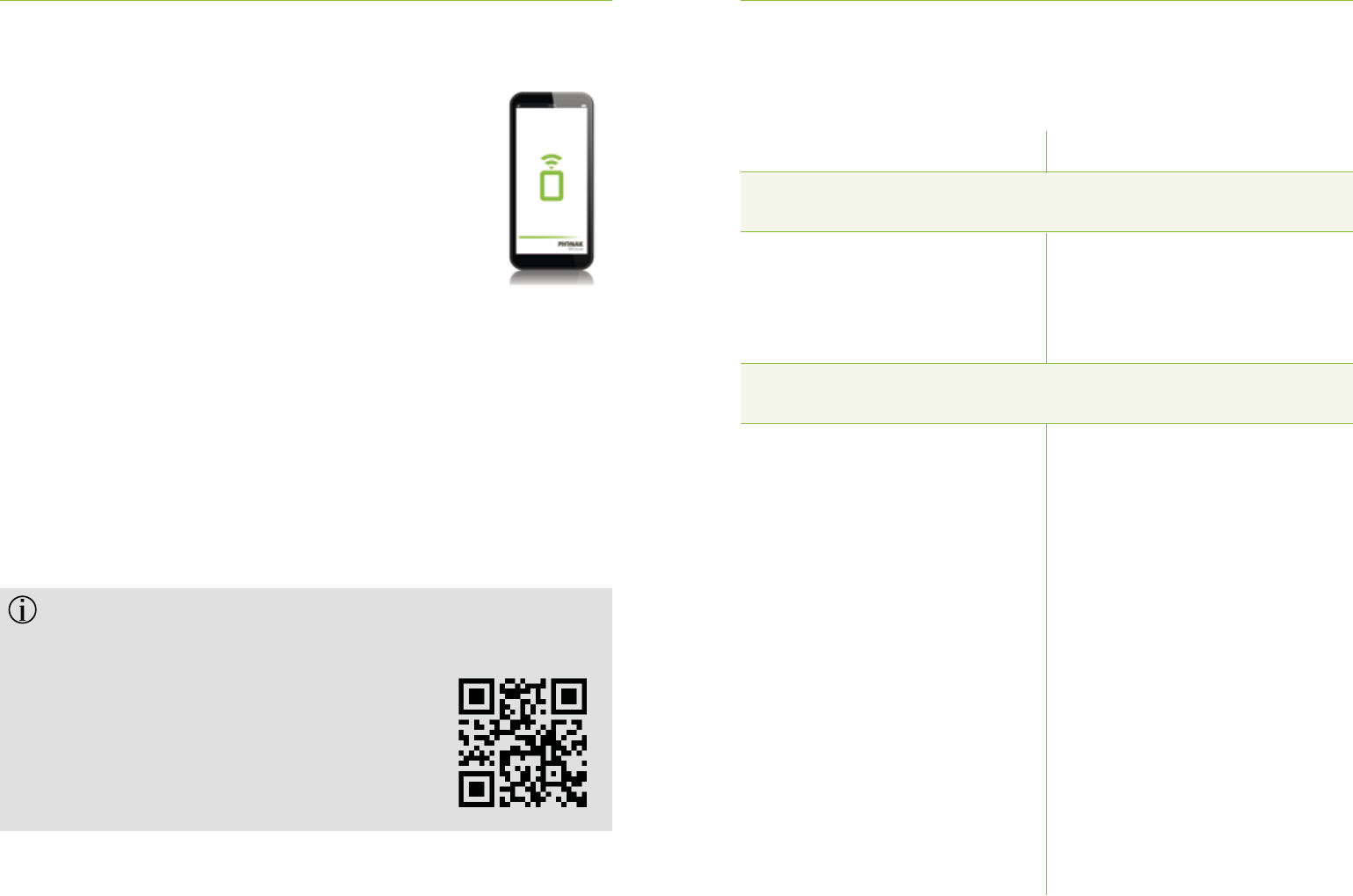
40 41
7.9 Phonak RemoteControl App
The Phonak RemoteControl App is a
Smartphone application, which oers
additional control of your hearing
aid.
Features are visualized on your Smartphone screen and
give you the ability to partially congure your hearing
system.
Experience more:
Individual left / right volume control.
Direct program or alternative audio input selection.
Support for the Bluetooth pairing process.
For more information and to download of the
RemoteControl App visit the website:
http://www.phonak.com/rcapp
For any problems not listed in this user guide, please contact
your hearing care professional.
Causes
During Bluetooth pairing my other device is prompting
for a code, what do I have to enter?
The pairing code is required
for the initial coupling of
ComPilot Air II with your
Bluetooth device (“pairing”).
I hear intermittency during an audio transfer via
ComPilot Air II.
The Bluetooth device is too
far away, or worn in a back
pocket (body shielding).
ComPilot Air II searches for
known devices for 2 minutes
after switching on.
A phone connected to other
devices such as a PC may
not be able to continuously
stream music.
What to do
Enter "0000" (four zeros)
when prompted for a code.
Do not exceed the maximum
distance 5–10 m (15–30 ft.)
and keep Bluetooth devices in
front of you.
After 2 minutes, ComPilot
Air II will stop searching and
the intermittency will stop.
When using your Bluetooth
phone as music player,
disconnect it from other
devices such as PCs.
8. Troubleshooting

42 43
Causes What to do
The volume of the music or phone conversation is too loud or
too quiet.
Dierent audio sources have
dierent outputs.
I have diculties understanding the phone conversation in a
noisy environment.
Your hearing aid
microphones are set too
high during the call.
The caller can hear me but I cannot hear the caller.
The call was transferred to
your phone.
Some phones, when accepting
the call through the phone
button, don’t use ComPilot
Air II.
To change the volume of the
phone, or any other sound
source to ComPilot Air II, use
the volume control of that
external device.
Reduce the environmental
noise by pressing the
button for 2 seconds (see
chapter 6.1).
Use the phone volume button
to increase the phone volume.
Make sure the call is
transferred back to ComPilot
Air II via the phone menu.
Always accept the call
by pressing the main
button.
ComPilot Air II is no longer recognized by the phone or other
Bluetooth devices to which it was previously paired.
2 minutes after not nding a
device, ComPilot Air II will stop
seeking devices to save power.
The devices are too far away
from each other.
ComPilot Air II can be paired
to a maximum of 6 dierent
Bluetooth devices. If the
internal memory is full, new
pairings may overwrite previous
pairings.
Pairing was deleted.
I am not streaming but the hearing aids keep switching
between the streaming and the normal hearing aid program.
Your phone sends sounds to
ComPilot Air II due to incoming
SMS or mails.
Phone key tones are switched
on.
Causes
Switch ComPilot Air II o.
Wait until the red indicator
light switches o, then turn
on again.
Bring devices within 1 meter
range and try again.
Repeat the pairing between
ComPilot Air II and the
Bluetooth device which was
overwritten.
Repeat the pairing between
ComPilot Air II and the
Bluetooth device which was
deleted.
Disable the system sounds for
reminders, alarms, SMS, etc.,
via your phone menu.
Switch o phone key tones via
your phone menu.
What to do
8. Troubleshooting
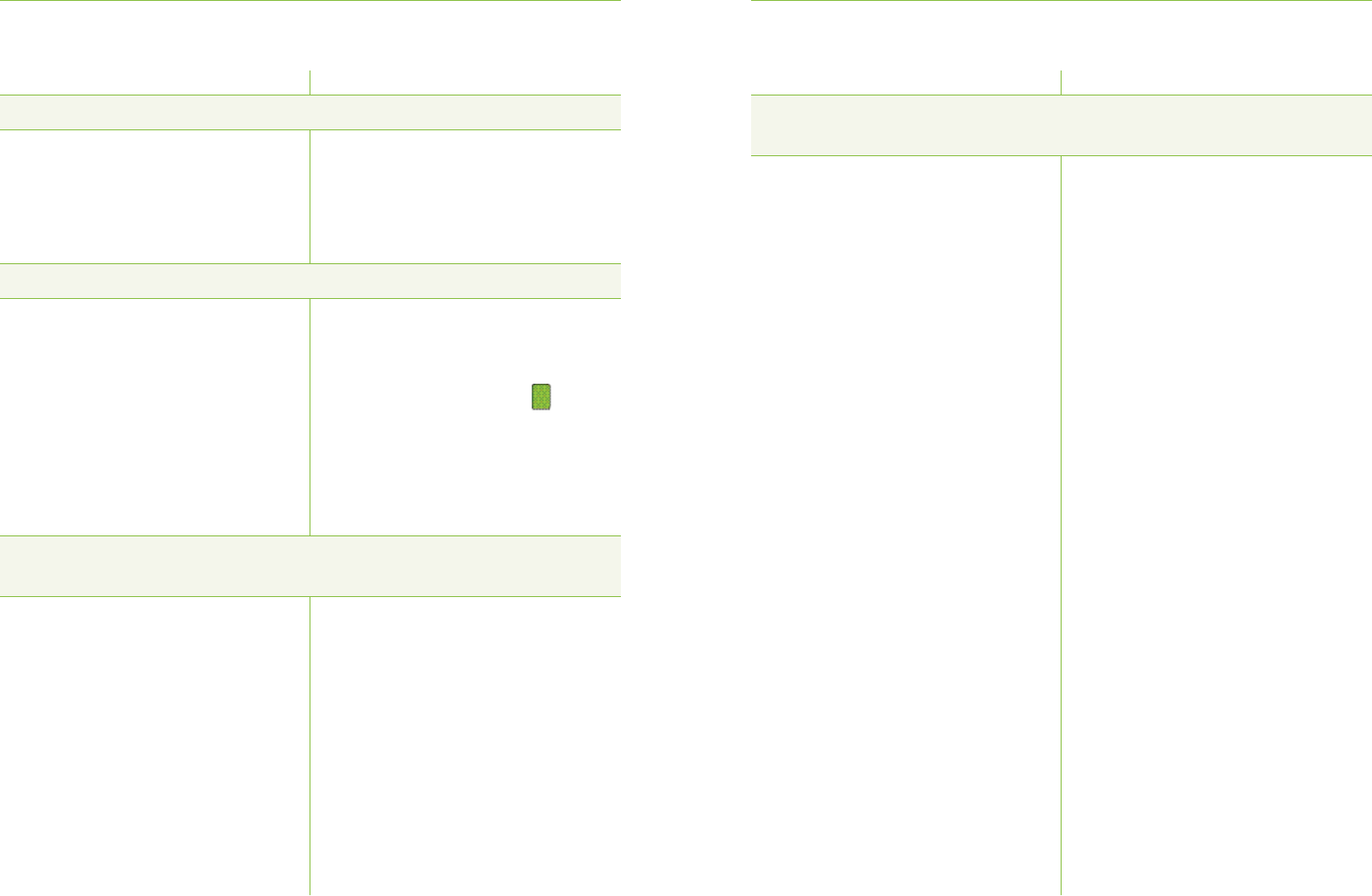
44 45
Causes What to do
I hear my phone’s key-press tones in my hearing aids.
The key-press tones may be
enabled on your phone.
Every time I switch on my phone, the music player starts.
For some phones this is
normal behavior and not
initiated by ComPilot Air II.
Every time I get in my car the ComPilot Air II connection to my
phone behaves unexpectedly.
The car Bluetooth system
connects to your phone.
Deactivate key-press and
conrmation tones on your
phone. Please refer to the
phone’s user guide.
Some phones can be
congured not to start the
music player automatically.
Press and hold main button
to stop streaming.
Stop the music player via
phone menu after the phone is
connected.
Consider disconnecting the car
system from your phone.
Causes What to do
Ensure Bluetooth is enabled
according to your phone’s user
guide.
1. Disable the Bluetooth
functionality in your phone
and turn it on again.
2. Restart ComPilot Air II by
switching it o and then on.
The Bluetooth functionality
will be automatically
reactivated.
3. Activate ComPilot Air II by
selecting it in the phone’s
“Active device” menu.
4. Reduce the distance to
phone.
Follow the pairing process in
this guide.
Wear ComPilot Air II clipped
to your cloth. Keep distance
to phone <10 m (<30 ft).
8. Troubleshooting
The phone is ringing but the indicator light is not solid blue and
there is no ringing signal through the hearing aids.
Bluetooth is disabled in the
phone.
ComPilot Air II and your
phone are not connected to
each other.
ComPilot Air II is not paired
to the phone.
The distance is too great
between ComPilot Air II and
the phone.

46 47
The phone is ringing, the indicator light is solid blue but
there is no ringing signal through the hearing aids.
ComPilot Air II is out of range
of the hearing aids.
Phone is set to vibrate.
You are already on a
phone call and a second
call cannot be recognized.
My phone rings but the name of the caller is not heard
acoustically.
The caller identication
feature is not available or not
enabled on your phone.
Two phones are connected to
your ComPilot Air II.
Caller identication may be
switched o.
Causes
Wear ComPilot Air II
correctly clipped to your cloth
with max. 40 cm (16") distance
to the hearing aids.
Enable ring tone on phone.
Hang up the rst phone call,
then accept the second call.
Please refer to the phone’s
user guide to check the
availability of this feature.
If two phones are connected
caller identication is only
available on the phone that
was last paired to ComPilot
Air II.
Please ask your hearing
care professional to enable
caller identication on
your ComPilot Air II.
What to do Causes What to do
During a phone call the other party has diculty hearing me.
ComPilot Air II microphone
opening may be covered.
ComPilot Air II may not be
worn correctly.
ComPilot Air II may rub
against clothing.
The surrounding noise may
be too loud.
ComPilot Air II is unresponsive or there is no indicator light
when switching On.
ComPilot Air II may be
completely discharged.
It may indicate a software
problem.
Make sure the microphone
opening is not covered by part
of your body, clothing
or dirt and debris.
Make sure your ComPilot
Air II is clipped securely to
cloth within 40 cm (16").
distance to your hearing aids.
Reduce movement while you
speak.
Bring ComPilot Air II closer to
your mouth.
Suggest to your callers that
they increase the phone
volume.
Charge for at least 1 hour.
Switch ComPilot Air II O,
wait 30 seconds, then switch
On again.
8. Troubleshooting

48 49
The operating time of your ComPilot Air II is reduced
substantially.
The battery typically needs
several charging cycles to
achieve full performance.
Please consult the datasheet
for the typical operating
time.
I have interruptions while my audio streaming is active.
ComPilot Air II is too far
away from the hearing aids
while streaming.
Bluetooth signal is out of
range.
I cannot hear the demo sound.
Hearing aids are not worn
correctly.
ComPilot Air II is not worn
correctly or switched O.
Causes
Charge for at least 3 hours
the rst time you charge
ComPilot Air II.
Let a new ComPilot Air II
discharge completely three
times.
Wear ComPilot Air II
clipped to your cloth with
max. 40 cm (16") distance
to the hearing aids.
Keep the Bluetooth device.
within the operating range.
Make sure your hearing aids
are inserted correctly.
Wear ComPilot Air II
clipped to your cloth with
max. 40 cm (16") distance
to the hearing aids.
Make sure ComPilot Air II is
charged and switched on.
What to do
9. Service and Warranty
9.1 Local warranty
Please ask the hearing care professional, where you
purchased your device, about the terms of the local
warranty.
9.2 International warranty
Phonak oers a one year limited international warranty,
valid as of the date of purchase. This limited warranty
covers manufacturing and material defects. The warranty
only comes into force if proof of purchase is shown.
The international warranty does not aect any legal
rights that you might have under applicable national
legislation governing sale of consumer goods.
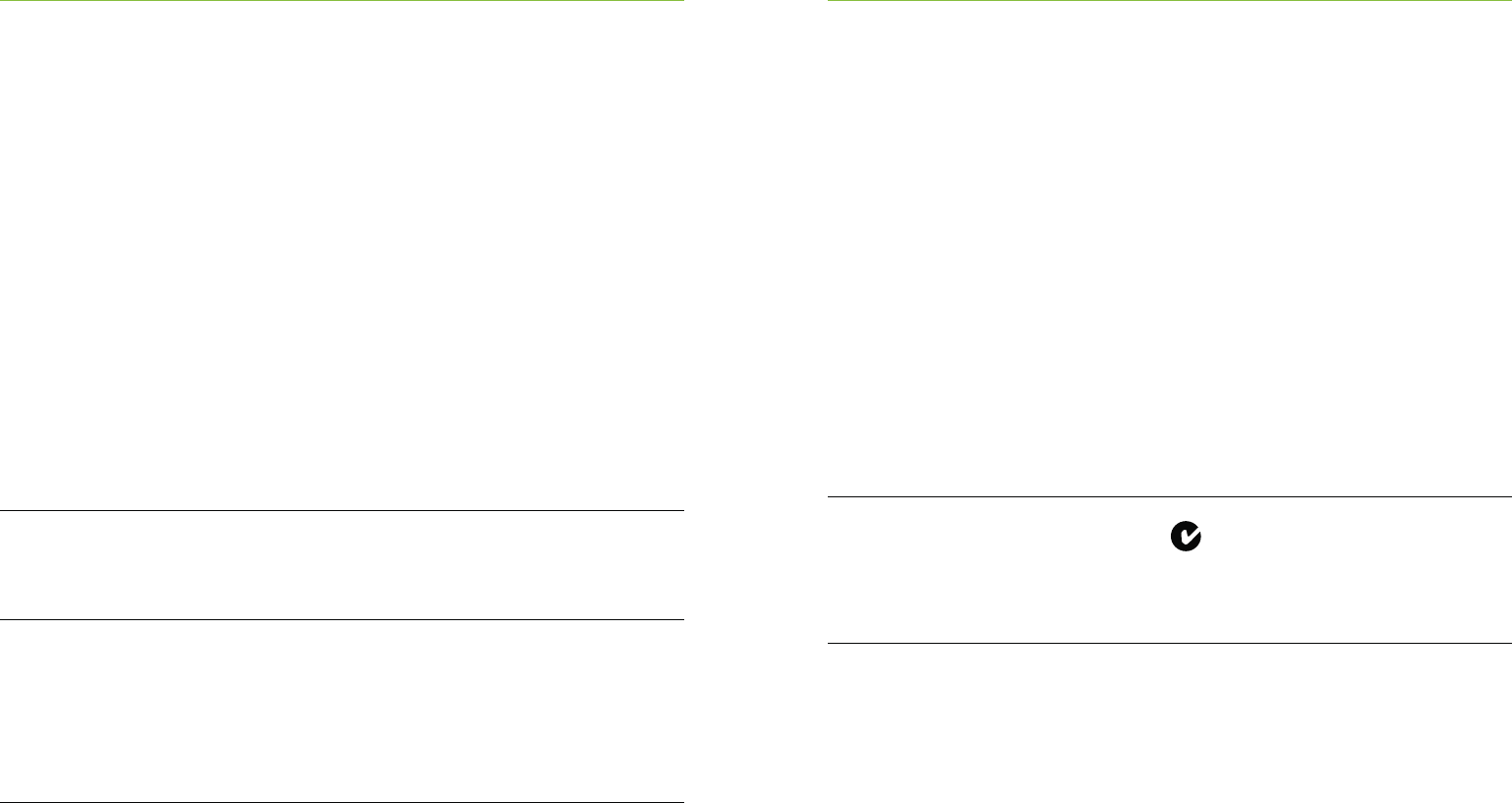
50 51
9.3 Warranty limitation
This warranty does not cover damage from improper
handling or care, exposure to chemicals, immersion in
water or undue stress. Damage caused by third parties
or non-authorized service centers renders the warranty
null and void. This warranty does not include any
services performed by a hearing care professional in
their oce.
Serial number:
Date of purchase:
Authorized hearing
care professional
(stamp / signature):
Declaration of conformity
Hereby Phonak AG declares that this Phonak product is
in compliance with the essential requirements of the
Medical Devices Directive 93/42/EEC as well as the Radio
and Telecommunications Terminal Equipment Directive
1999/5/EC. The full text of the Declaration of Conformity
can be obtained from the manufacturer or the local
Phonak representative whose address can be taken from
the list on http://www.phonak.com (worldwide locations).
Australia:
Supplier Code Number N15398
New Zealand:
Supplier Code Number Z1285
10. Compliance information

52 53
Notice 1:
This device complies with Part 15 of the FCC Rules and
with RSS-210 of Industry Canada. Operation is subject to
the following two conditions:
1) this device may not cause harmful interference, and
2) this device must accept any interference received,
including interference that may cause undesired
operation.
Notice 2:
Changes or modications made to this device not
expressly approved by Phonak may void the FCC
authorization to operate this device.
Notice 3:
This device has been tested and found to comply with the
limits for a Class B digital device, pursuant to Part 15
of the FCC Rules and ICES-003 of Industry Canada. These
limits are designed to provide reasonable protection
against harmful interference in a residential installation.
This device generates, uses and can radiate radio
frequency energy and, if not installed and used in
accordance with the instructions, may cause harmful
interference to radio communications.
However, there is no guarantee that interference will not
occur in a particular installation. If this device does
cause harmful interference to radio or television reception,
which can be determined by turning the equipment
o and on, the user is encouraged to try to correct the
interference by one or more of the following measures:
Reorient or relocate the receiving antenna.
Increase the separation between the device and
receiver.
Connect the device into an outlet on a circuit
dierent from that to which the receiver is
connected.
Consult the dealer or an experienced radio / TV
technician for help.
Notice 4:
Japanese Radio Law and Japanese Telecommunications
Business Law Compliance. This device is granted pursuant
to the Japanese Radio Law (電波法) and the Japanese
Telecommunications Business Law (電気通信事業法).
This device should not be modied (otherwise the granted
designation number will become invalid)."
10. Compliance information
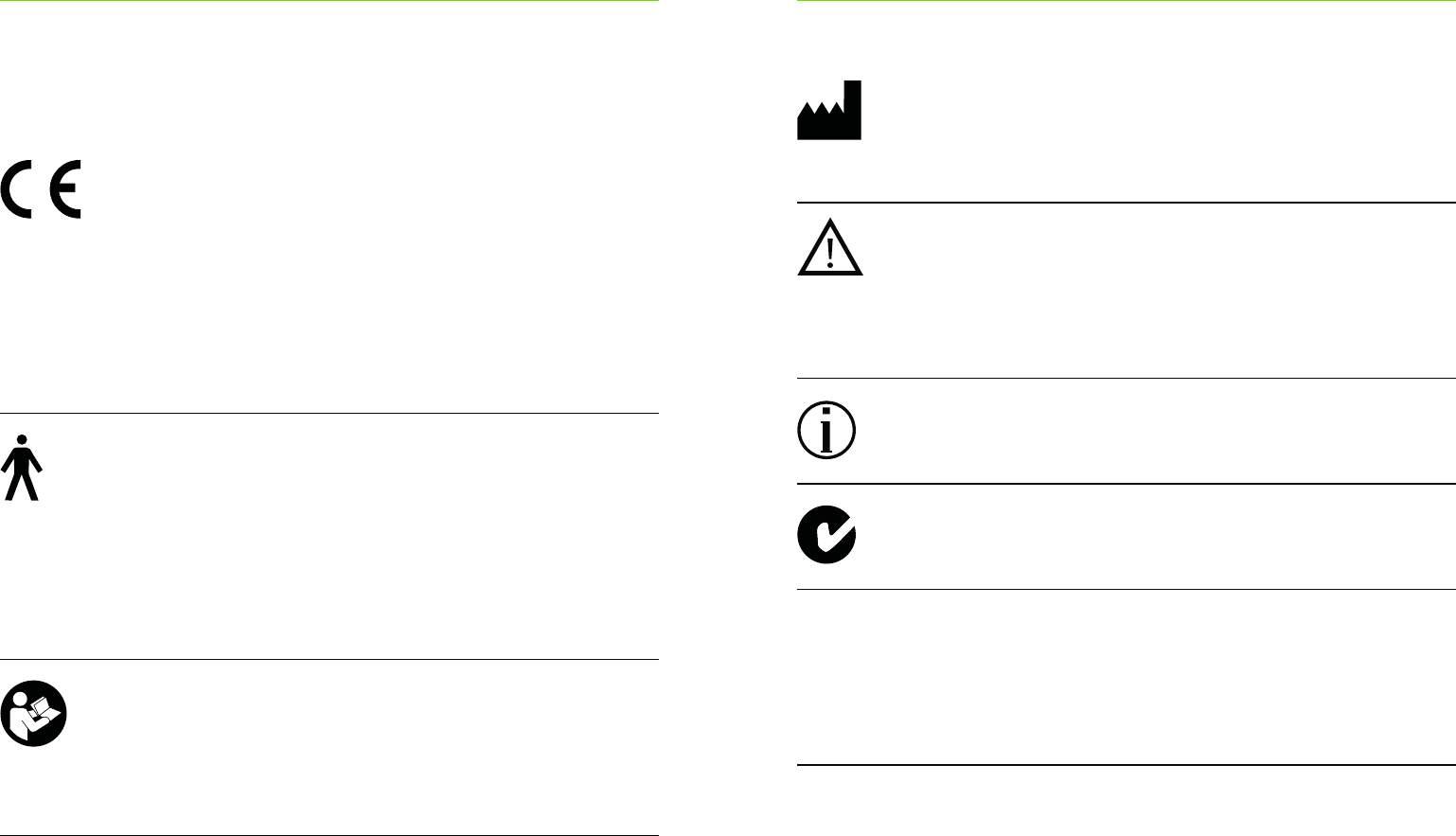
54 55
11. Information and explanation of
symbols
With the CE symbol, Phonak AG
conrms that this Phonak product
meets the requirements of the
Medical Devices Directive 93/42/EEC as
well as the R&TTE Directive 1999/5/EC
on radio and telecommunications
equipment.
This symbol indicates that the products
described in these user instructions
adhere to the requirements for an
applied part of Type B of EN 60601-1.
The surface of the device is specied
as an applied part of Type B.
This symbol indicates that it is
important for the user to read and
take into account the relevant
information in this user guide.
The device is designed such that
it functions without problems or
restrictions if used as intended, unless
otherwise noted in this user guide.
Operating
conditions
Important information for handling
and product safety.
This symbol indicates that it is
important for the user to pay attention
to the relevant warning notices in
these user guides.
EMC and radio communications
compliance label Australia.
Indicates the medical device
manufacturer, as dened in EU
Directive 93/42/EEC.
11. Information and explanation of symbols
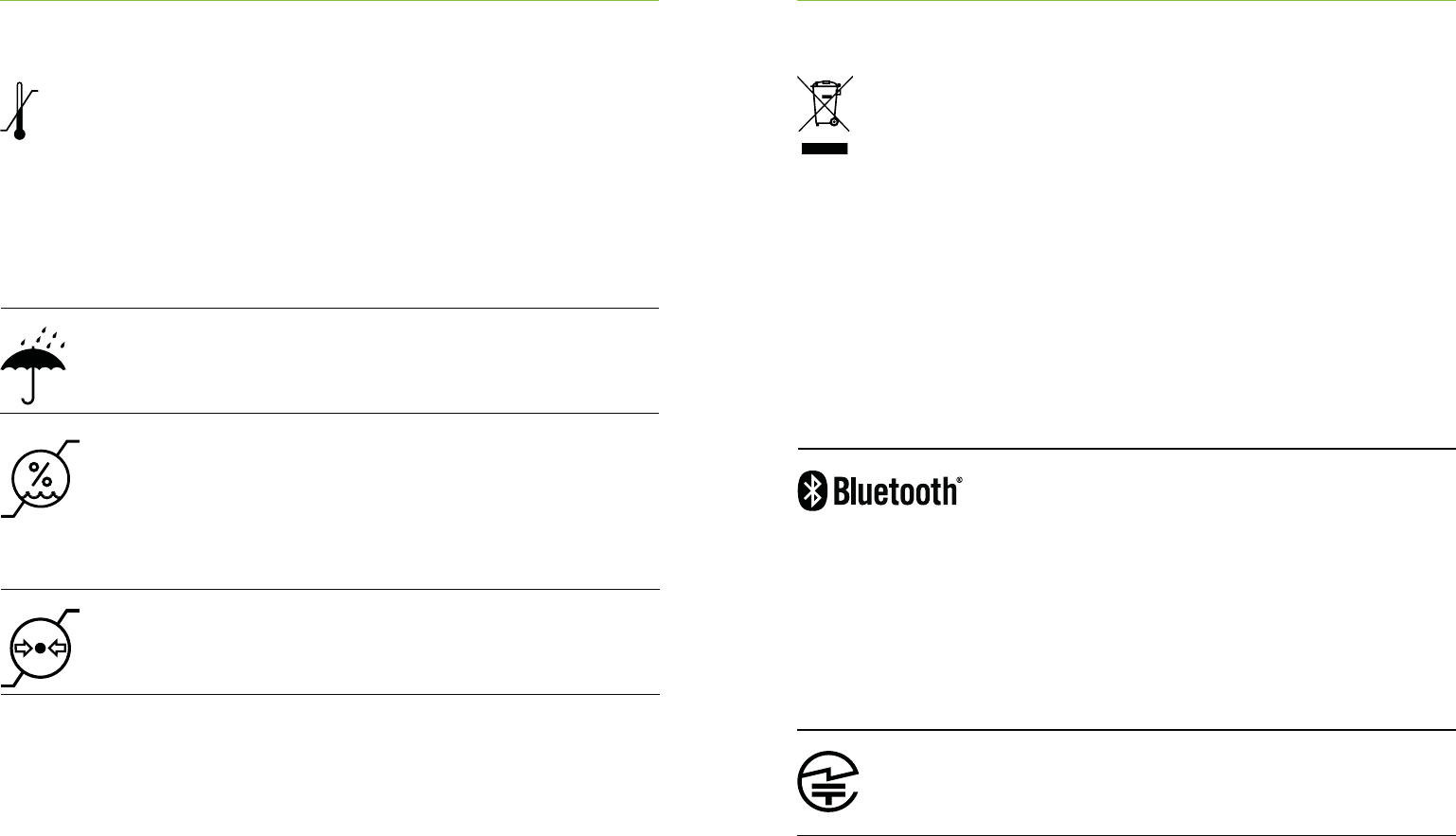
56 57
Keep dry.
Humidity transportation and storage:
<90% (non condensing).
Humidity operation: <95% (non
condensing).
Atmospheric pressure: 200 hPA to
1500 hPA.
Temperature transport and storage:
–20°C to +60°C
(–4° to +140° Fahrenheit)
Temperature operation:
0° to 40° Celsius
(+32° to +104° Fahrenheit)
The symbol with the crossed-out
garbage bin is to make you aware
that this device may not be thrown
away as normal household waste.
Please dispose of old or unused device,
at waste disposal sites intended for
electronic waste, or give your device
to your hearing care professional
for disposal. Proper disposal protects
the environment and health.
The Bluetooth® word mark and logos
are registered trademarks owned
by Bluetooth SIG, Inc. and any use
of such marks by Phonak is under
license. Other trademarks and trade
names are those of their respective
owners.
Japanese mark for certified radio
equipment.
11. Information and explanation of symbols
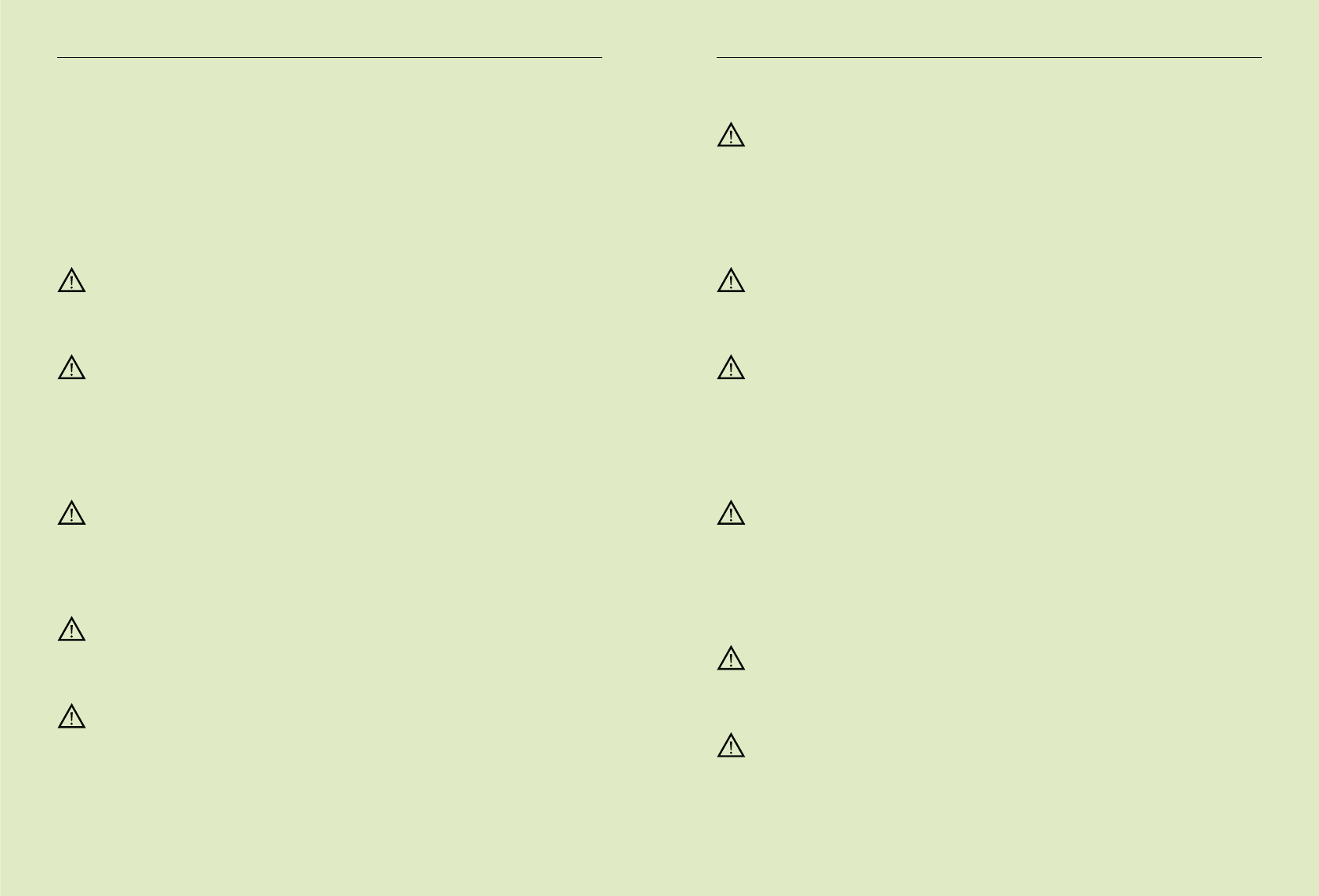
58 59
The following pages contain important safety
information.
Hazard warnings
Keep this device out of reach of children and
mentally challenged people or pets.
For persons with active implantable medical devices
(i.e. pacemakers, debrillators, etc.) the use of
this device is not permitted. Ask your hearing care
professional for details.
Only use hearing aids that have been specially
programmed for you by your hearing care
professional.
Changes or modications to the device that were
not explicitly approved by Phonak are not permitted.
Opening the device might damage it. If problems
occur which cannot be resolved by following the
remedy guidelines in the troubleshooting section of
this user guide, consult your hearing care professional.
12. Important safety information
This product has an embedded, non-replaceable
battery. Do not attempt to open the product or remove
the battery as this may cause injury and damage the
product.
Dispose of electrical components in accordance with
your local regulations by Phonak AG.
External devices may only be connected if they have
been tested in accordance with corresponding
IECXXXXX standards. Only use accessories approved
by Phonak AG, to avoid any electrical shock.
Using the device, its connectors or cables in any way
contradictory to their intended purpose as described
in this user guide (e.g., wearing the USB cable
around the neck) can cause injury.
When operating machinery, ensure that no parts get
caught in the machine.
The mini-USB port is to be used for the described
purpose only.
12. Important safety information
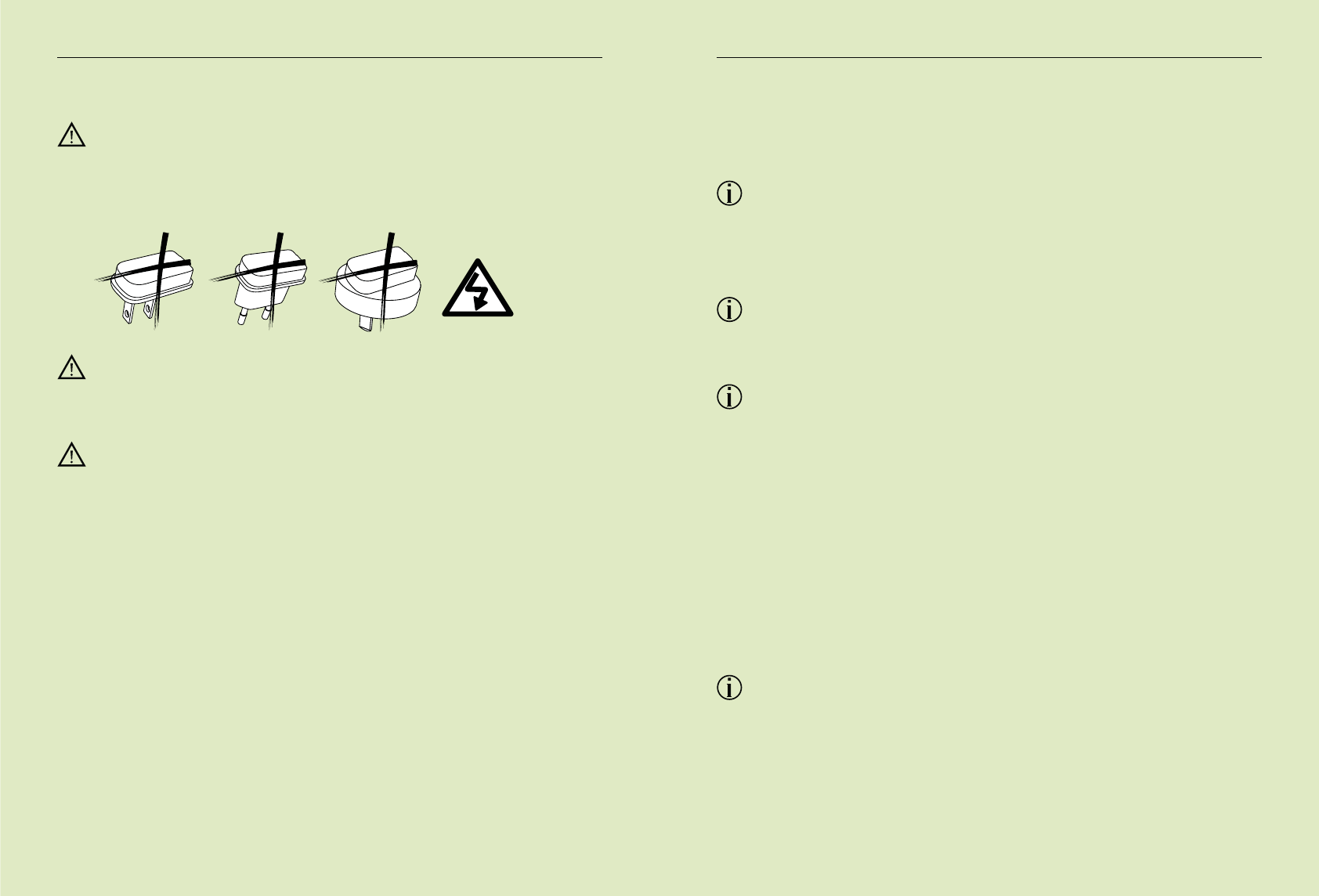
60 61
For safety reasons, only use chargers supplied by
Phonak or stabilized chargers with a rating of 5 VDC,
min. 500 mA.
Caution: electric shock. Do not insert plug alone into
electrical outlets.
Do not use the device in explosive areas (mines
or industrial areas with danger of explosions, oxygen-
rich environments or areas where ammable
anesthetics are handled) or where electronic
equipment is prohibited.
Information on product safety
Protect the device from excessive moisture (bathing,
swimming), heat (radiator, car dashboard) or direct
skin contact when sweating (workout, tness, sport).
Do not drop the device. Dropping onto a hard surface
can damage the device.
Special medical or dental examination including
radiation described below, may adversely aect the
correct functioning of your device. Remove and
keep it outside the examination room/area before
undergoing:
Medical or dental examination with X-ray
(also CT scan).
Medical examinations with MRI/NMRI scans,
generating magnetic elds.
Protect the device, charging slot and power supply
from dirt and debris.
12. Important safety information

62 63
Clean the device using a damp cloth. Never use
household cleaning products (washing powder, soap,
etc.) or alcohol to clean the device. Never use a
microwave or other heating devices to dry the device.
The digitally coded, inductive transmission technology
used in the device is highly reliable and experiences
virtually no interference from other devices. It
should be noted, however, that when operating the
hearing system near computer equipment, larger
electronic installations or other strong electromagnetic
elds, it may be necessary to be at least 60 cm (24")
away from the interfering device to ensure proper
operation.
Keep the device at least 10 cm away from any kind
of magnets.
Do not connect an USB cable exceeding 3 meters
(9 ft) in length to the device.
When the device is not in use, turn it o and store
it safely.
Other important information
High-powered electronic equipment, larger electronic
installations and metallic structures may impair and
signicantly reduce the operating range.
If the hearing aids do not respond to the device
because of an unusual eld disturbance, move away
from the disturbing eld.
12. Important safety information